Comparative Analysis of Underarm and Overarm Throwing in Cricket
VerifiedAdded on 2023/06/10
|26
|5455
|154
Project
AI Summary
This project delves into the comparative analysis of underarm and overarm throwing techniques within the context of cricket, focusing on the biomechanical distinctions between the two methods. The study examines a male cricket player, analyzing the preparation, execution, and follow-through phases of each throw type. Using Kinovea software and a high-definition camera, the project records and analyzes the angles between the shoulder and elbow joints, aiming to identify key differences in movement patterns. The research highlights the importance of muscle contraction, noting that underarm throws necessitate more flexion, engaging biceps and anterior deltoid fibers, whereas overarm throws require more extension, involving triceps and posterior deltoid fibers. The project underscores the significance of these differences in enhancing cricket players' performance, offering insights into the dynamics of throwing speed and accuracy.
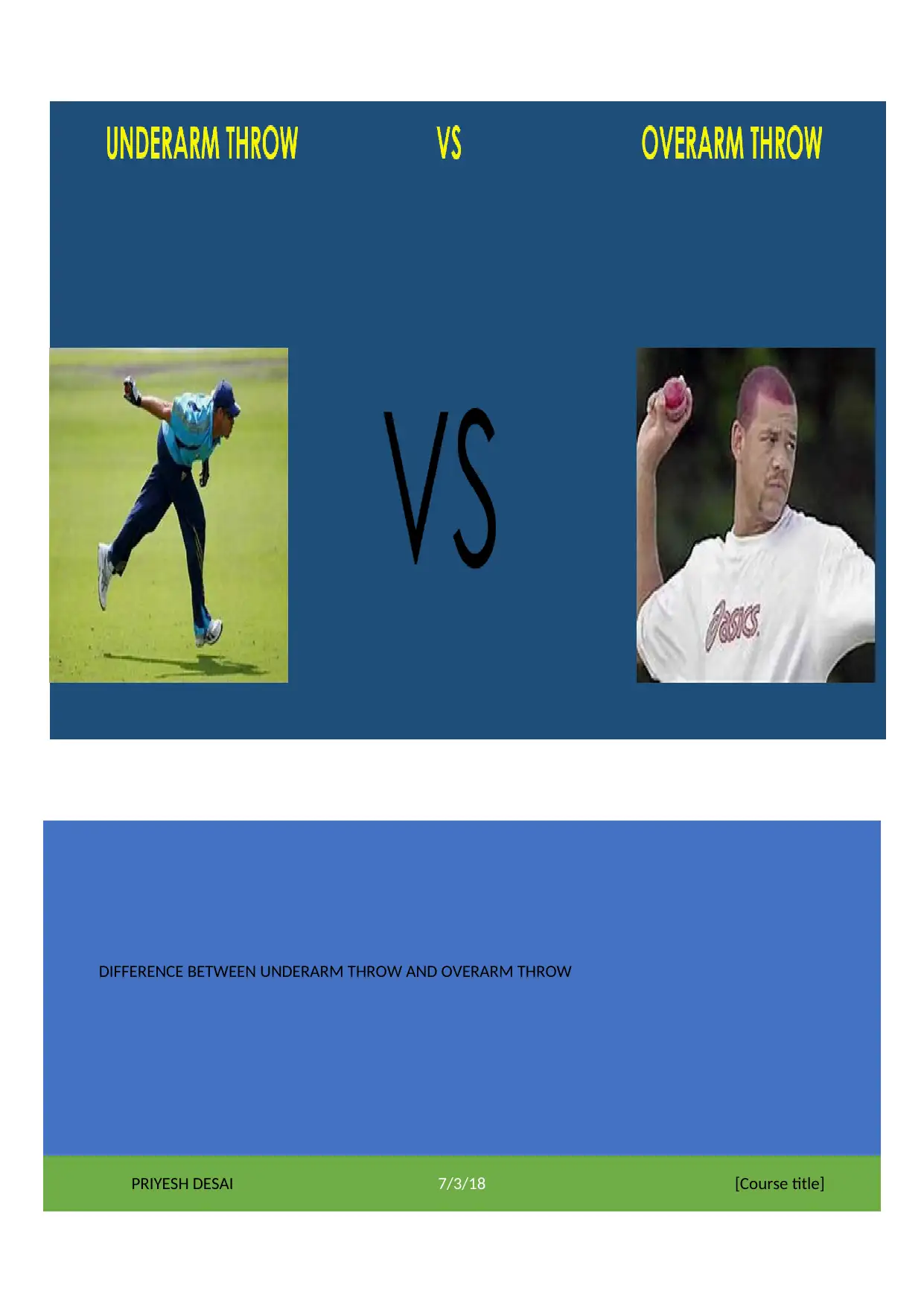
DIFFERENCE BETWEEN UNDERARM THROW AND OVERARM THROW
PRIYESH DESAI 7/3/18 [Course title]
PRIYESH DESAI 7/3/18 [Course title]
Secure Best Marks with AI Grader
Need help grading? Try our AI Grader for instant feedback on your assignments.
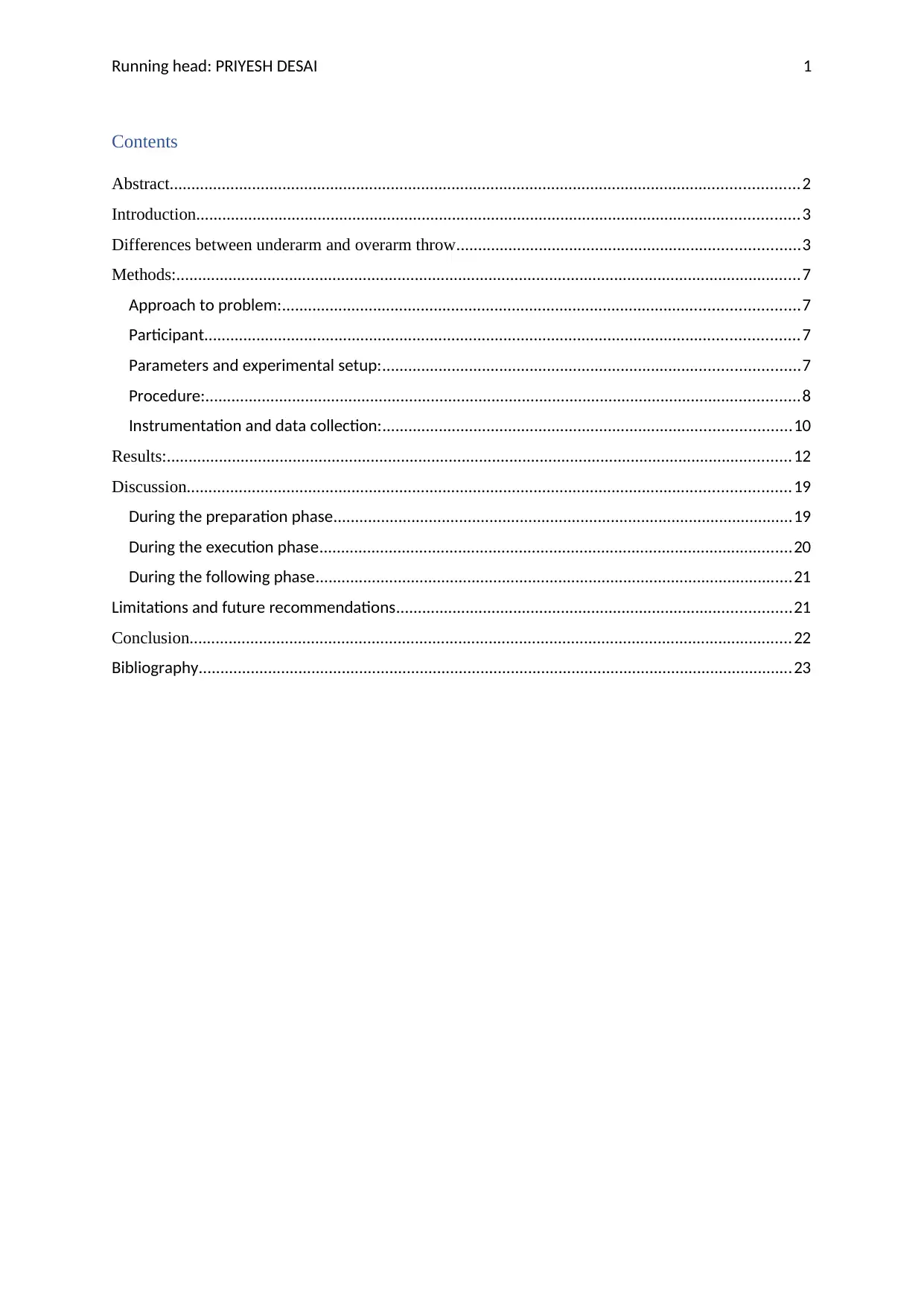
Running head: PRIYESH DESAI 1
Contents
Abstract.................................................................................................................................................2
Introduction...........................................................................................................................................3
Differences between underarm and overarm throw...............................................................................3
Methods:................................................................................................................................................7
Approach to problem:.......................................................................................................................7
Participant.........................................................................................................................................7
Parameters and experimental setup:................................................................................................7
Procedure:.........................................................................................................................................8
Instrumentation and data collection:..............................................................................................10
Results:................................................................................................................................................12
Discussion...........................................................................................................................................19
During the preparation phase..........................................................................................................19
During the execution phase.............................................................................................................20
During the following phase..............................................................................................................21
Limitations and future recommendations...........................................................................................21
Conclusion...........................................................................................................................................22
Bibliography.........................................................................................................................................23
Contents
Abstract.................................................................................................................................................2
Introduction...........................................................................................................................................3
Differences between underarm and overarm throw...............................................................................3
Methods:................................................................................................................................................7
Approach to problem:.......................................................................................................................7
Participant.........................................................................................................................................7
Parameters and experimental setup:................................................................................................7
Procedure:.........................................................................................................................................8
Instrumentation and data collection:..............................................................................................10
Results:................................................................................................................................................12
Discussion...........................................................................................................................................19
During the preparation phase..........................................................................................................19
During the execution phase.............................................................................................................20
During the following phase..............................................................................................................21
Limitations and future recommendations...........................................................................................21
Conclusion...........................................................................................................................................22
Bibliography.........................................................................................................................................23
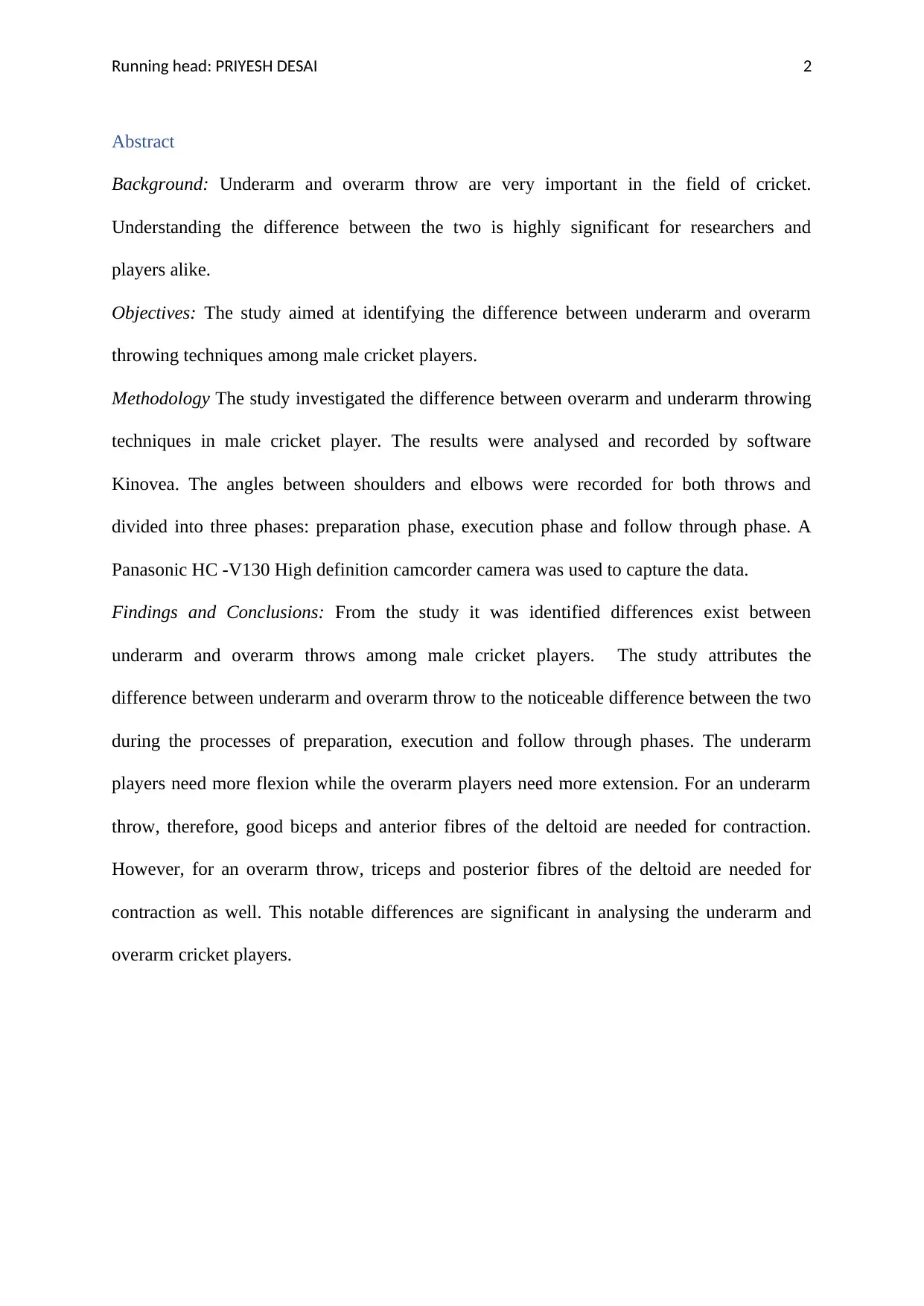
Running head: PRIYESH DESAI 2
Abstract
Background: Underarm and overarm throw are very important in the field of cricket.
Understanding the difference between the two is highly significant for researchers and
players alike.
Objectives: The study aimed at identifying the difference between underarm and overarm
throwing techniques among male cricket players.
Methodology The study investigated the difference between overarm and underarm throwing
techniques in male cricket player. The results were analysed and recorded by software
Kinovea. The angles between shoulders and elbows were recorded for both throws and
divided into three phases: preparation phase, execution phase and follow through phase. A
Panasonic HC -V130 High definition camcorder camera was used to capture the data.
Findings and Conclusions: From the study it was identified differences exist between
underarm and overarm throws among male cricket players. The study attributes the
difference between underarm and overarm throw to the noticeable difference between the two
during the processes of preparation, execution and follow through phases. The underarm
players need more flexion while the overarm players need more extension. For an underarm
throw, therefore, good biceps and anterior fibres of the deltoid are needed for contraction.
However, for an overarm throw, triceps and posterior fibres of the deltoid are needed for
contraction as well. This notable differences are significant in analysing the underarm and
overarm cricket players.
Abstract
Background: Underarm and overarm throw are very important in the field of cricket.
Understanding the difference between the two is highly significant for researchers and
players alike.
Objectives: The study aimed at identifying the difference between underarm and overarm
throwing techniques among male cricket players.
Methodology The study investigated the difference between overarm and underarm throwing
techniques in male cricket player. The results were analysed and recorded by software
Kinovea. The angles between shoulders and elbows were recorded for both throws and
divided into three phases: preparation phase, execution phase and follow through phase. A
Panasonic HC -V130 High definition camcorder camera was used to capture the data.
Findings and Conclusions: From the study it was identified differences exist between
underarm and overarm throws among male cricket players. The study attributes the
difference between underarm and overarm throw to the noticeable difference between the two
during the processes of preparation, execution and follow through phases. The underarm
players need more flexion while the overarm players need more extension. For an underarm
throw, therefore, good biceps and anterior fibres of the deltoid are needed for contraction.
However, for an overarm throw, triceps and posterior fibres of the deltoid are needed for
contraction as well. This notable differences are significant in analysing the underarm and
overarm cricket players.
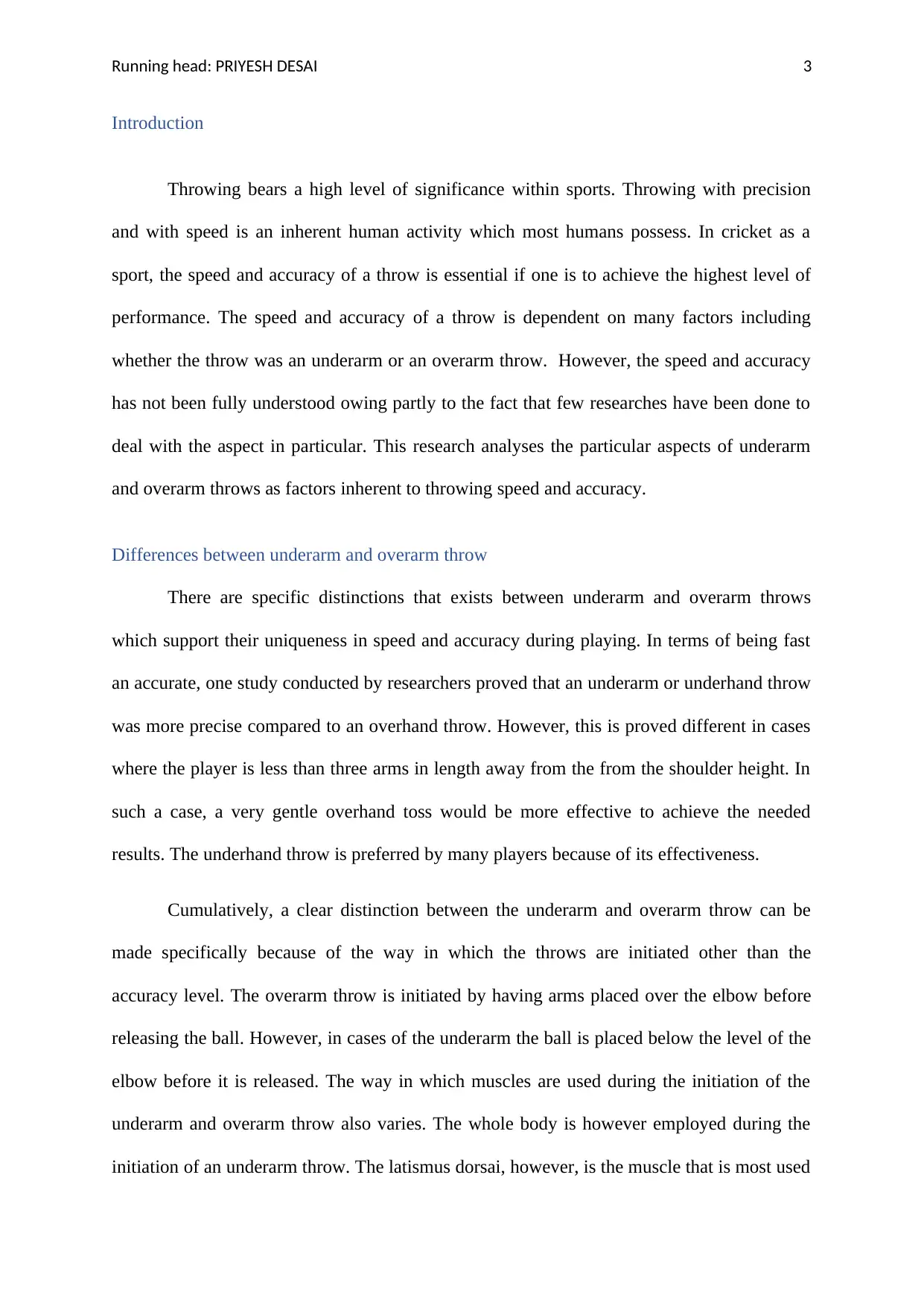
Running head: PRIYESH DESAI 3
Introduction
Throwing bears a high level of significance within sports. Throwing with precision
and with speed is an inherent human activity which most humans possess. In cricket as a
sport, the speed and accuracy of a throw is essential if one is to achieve the highest level of
performance. The speed and accuracy of a throw is dependent on many factors including
whether the throw was an underarm or an overarm throw. However, the speed and accuracy
has not been fully understood owing partly to the fact that few researches have been done to
deal with the aspect in particular. This research analyses the particular aspects of underarm
and overarm throws as factors inherent to throwing speed and accuracy.
Differences between underarm and overarm throw
There are specific distinctions that exists between underarm and overarm throws
which support their uniqueness in speed and accuracy during playing. In terms of being fast
an accurate, one study conducted by researchers proved that an underarm or underhand throw
was more precise compared to an overhand throw. However, this is proved different in cases
where the player is less than three arms in length away from the from the shoulder height. In
such a case, a very gentle overhand toss would be more effective to achieve the needed
results. The underhand throw is preferred by many players because of its effectiveness.
Cumulatively, a clear distinction between the underarm and overarm throw can be
made specifically because of the way in which the throws are initiated other than the
accuracy level. The overarm throw is initiated by having arms placed over the elbow before
releasing the ball. However, in cases of the underarm the ball is placed below the level of the
elbow before it is released. The way in which muscles are used during the initiation of the
underarm and overarm throw also varies. The whole body is however employed during the
initiation of an underarm throw. The latismus dorsai, however, is the muscle that is most used
Introduction
Throwing bears a high level of significance within sports. Throwing with precision
and with speed is an inherent human activity which most humans possess. In cricket as a
sport, the speed and accuracy of a throw is essential if one is to achieve the highest level of
performance. The speed and accuracy of a throw is dependent on many factors including
whether the throw was an underarm or an overarm throw. However, the speed and accuracy
has not been fully understood owing partly to the fact that few researches have been done to
deal with the aspect in particular. This research analyses the particular aspects of underarm
and overarm throws as factors inherent to throwing speed and accuracy.
Differences between underarm and overarm throw
There are specific distinctions that exists between underarm and overarm throws
which support their uniqueness in speed and accuracy during playing. In terms of being fast
an accurate, one study conducted by researchers proved that an underarm or underhand throw
was more precise compared to an overhand throw. However, this is proved different in cases
where the player is less than three arms in length away from the from the shoulder height. In
such a case, a very gentle overhand toss would be more effective to achieve the needed
results. The underhand throw is preferred by many players because of its effectiveness.
Cumulatively, a clear distinction between the underarm and overarm throw can be
made specifically because of the way in which the throws are initiated other than the
accuracy level. The overarm throw is initiated by having arms placed over the elbow before
releasing the ball. However, in cases of the underarm the ball is placed below the level of the
elbow before it is released. The way in which muscles are used during the initiation of the
underarm and overarm throw also varies. The whole body is however employed during the
initiation of an underarm throw. The latismus dorsai, however, is the muscle that is most used
Secure Best Marks with AI Grader
Need help grading? Try our AI Grader for instant feedback on your assignments.
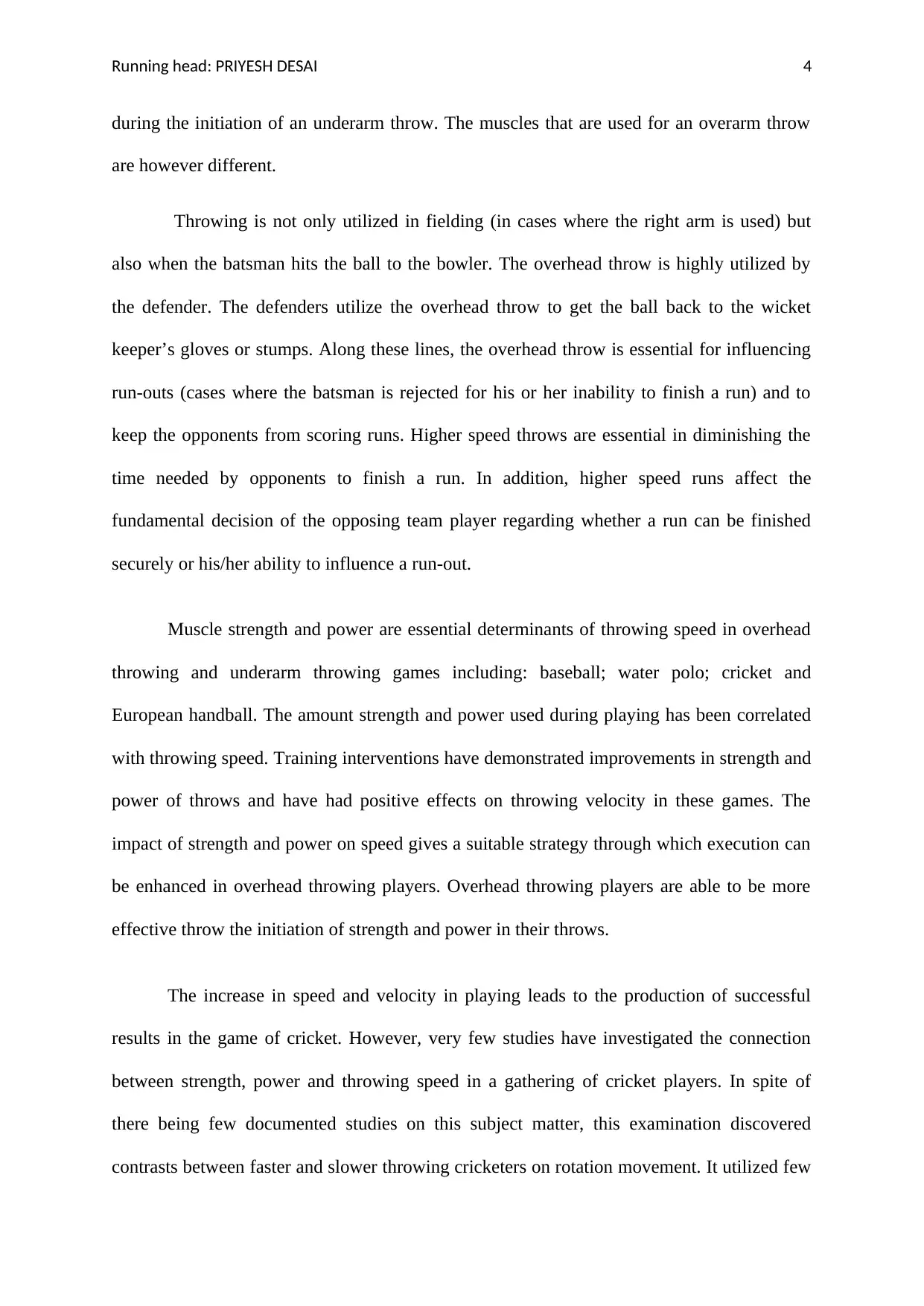
Running head: PRIYESH DESAI 4
during the initiation of an underarm throw. The muscles that are used for an overarm throw
are however different.
Throwing is not only utilized in fielding (in cases where the right arm is used) but
also when the batsman hits the ball to the bowler. The overhead throw is highly utilized by
the defender. The defenders utilize the overhead throw to get the ball back to the wicket
keeper’s gloves or stumps. Along these lines, the overhead throw is essential for influencing
run-outs (cases where the batsman is rejected for his or her inability to finish a run) and to
keep the opponents from scoring runs. Higher speed throws are essential in diminishing the
time needed by opponents to finish a run. In addition, higher speed runs affect the
fundamental decision of the opposing team player regarding whether a run can be finished
securely or his/her ability to influence a run-out.
Muscle strength and power are essential determinants of throwing speed in overhead
throwing and underarm throwing games including: baseball; water polo; cricket and
European handball. The amount strength and power used during playing has been correlated
with throwing speed. Training interventions have demonstrated improvements in strength and
power of throws and have had positive effects on throwing velocity in these games. The
impact of strength and power on speed gives a suitable strategy through which execution can
be enhanced in overhead throwing players. Overhead throwing players are able to be more
effective throw the initiation of strength and power in their throws.
The increase in speed and velocity in playing leads to the production of successful
results in the game of cricket. However, very few studies have investigated the connection
between strength, power and throwing speed in a gathering of cricket players. In spite of
there being few documented studies on this subject matter, this examination discovered
contrasts between faster and slower throwing cricketers on rotation movement. It utilized few
during the initiation of an underarm throw. The muscles that are used for an overarm throw
are however different.
Throwing is not only utilized in fielding (in cases where the right arm is used) but
also when the batsman hits the ball to the bowler. The overhead throw is highly utilized by
the defender. The defenders utilize the overhead throw to get the ball back to the wicket
keeper’s gloves or stumps. Along these lines, the overhead throw is essential for influencing
run-outs (cases where the batsman is rejected for his or her inability to finish a run) and to
keep the opponents from scoring runs. Higher speed throws are essential in diminishing the
time needed by opponents to finish a run. In addition, higher speed runs affect the
fundamental decision of the opposing team player regarding whether a run can be finished
securely or his/her ability to influence a run-out.
Muscle strength and power are essential determinants of throwing speed in overhead
throwing and underarm throwing games including: baseball; water polo; cricket and
European handball. The amount strength and power used during playing has been correlated
with throwing speed. Training interventions have demonstrated improvements in strength and
power of throws and have had positive effects on throwing velocity in these games. The
impact of strength and power on speed gives a suitable strategy through which execution can
be enhanced in overhead throwing players. Overhead throwing players are able to be more
effective throw the initiation of strength and power in their throws.
The increase in speed and velocity in playing leads to the production of successful
results in the game of cricket. However, very few studies have investigated the connection
between strength, power and throwing speed in a gathering of cricket players. In spite of
there being few documented studies on this subject matter, this examination discovered
contrasts between faster and slower throwing cricketers on rotation movement. It utilized few
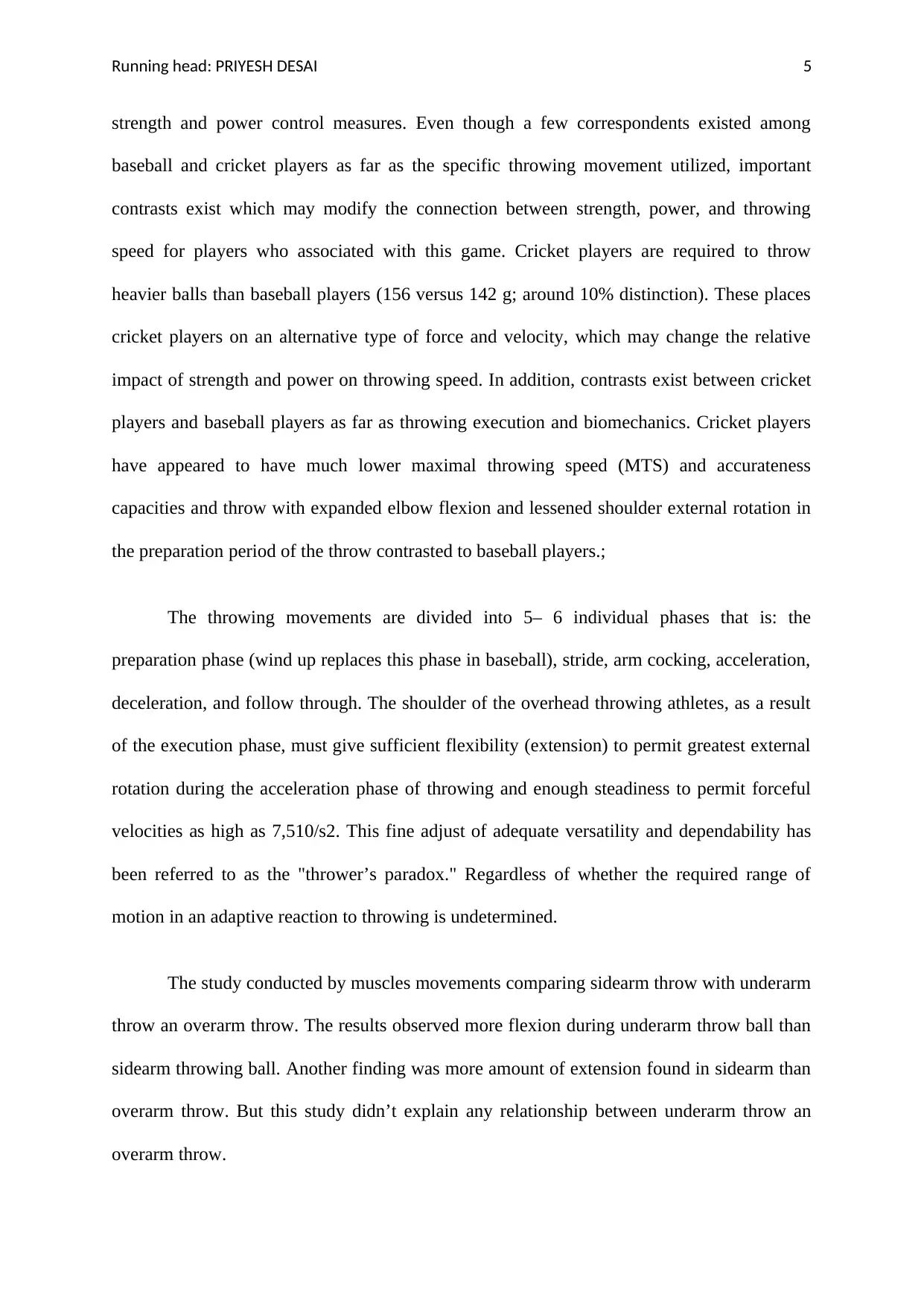
Running head: PRIYESH DESAI 5
strength and power control measures. Even though a few correspondents existed among
baseball and cricket players as far as the specific throwing movement utilized, important
contrasts exist which may modify the connection between strength, power, and throwing
speed for players who associated with this game. Cricket players are required to throw
heavier balls than baseball players (156 versus 142 g; around 10% distinction). These places
cricket players on an alternative type of force and velocity, which may change the relative
impact of strength and power on throwing speed. In addition, contrasts exist between cricket
players and baseball players as far as throwing execution and biomechanics. Cricket players
have appeared to have much lower maximal throwing speed (MTS) and accurateness
capacities and throw with expanded elbow flexion and lessened shoulder external rotation in
the preparation period of the throw contrasted to baseball players.;
The throwing movements are divided into 5– 6 individual phases that is: the
preparation phase (wind up replaces this phase in baseball), stride, arm cocking, acceleration,
deceleration, and follow through. The shoulder of the overhead throwing athletes, as a result
of the execution phase, must give sufficient flexibility (extension) to permit greatest external
rotation during the acceleration phase of throwing and enough steadiness to permit forceful
velocities as high as 7,510/s2. This fine adjust of adequate versatility and dependability has
been referred to as the "thrower’s paradox." Regardless of whether the required range of
motion in an adaptive reaction to throwing is undetermined.
The study conducted by muscles movements comparing sidearm throw with underarm
throw an overarm throw. The results observed more flexion during underarm throw ball than
sidearm throwing ball. Another finding was more amount of extension found in sidearm than
overarm throw. But this study didn’t explain any relationship between underarm throw an
overarm throw.
strength and power control measures. Even though a few correspondents existed among
baseball and cricket players as far as the specific throwing movement utilized, important
contrasts exist which may modify the connection between strength, power, and throwing
speed for players who associated with this game. Cricket players are required to throw
heavier balls than baseball players (156 versus 142 g; around 10% distinction). These places
cricket players on an alternative type of force and velocity, which may change the relative
impact of strength and power on throwing speed. In addition, contrasts exist between cricket
players and baseball players as far as throwing execution and biomechanics. Cricket players
have appeared to have much lower maximal throwing speed (MTS) and accurateness
capacities and throw with expanded elbow flexion and lessened shoulder external rotation in
the preparation period of the throw contrasted to baseball players.;
The throwing movements are divided into 5– 6 individual phases that is: the
preparation phase (wind up replaces this phase in baseball), stride, arm cocking, acceleration,
deceleration, and follow through. The shoulder of the overhead throwing athletes, as a result
of the execution phase, must give sufficient flexibility (extension) to permit greatest external
rotation during the acceleration phase of throwing and enough steadiness to permit forceful
velocities as high as 7,510/s2. This fine adjust of adequate versatility and dependability has
been referred to as the "thrower’s paradox." Regardless of whether the required range of
motion in an adaptive reaction to throwing is undetermined.
The study conducted by muscles movements comparing sidearm throw with underarm
throw an overarm throw. The results observed more flexion during underarm throw ball than
sidearm throwing ball. Another finding was more amount of extension found in sidearm than
overarm throw. But this study didn’t explain any relationship between underarm throw an
overarm throw.
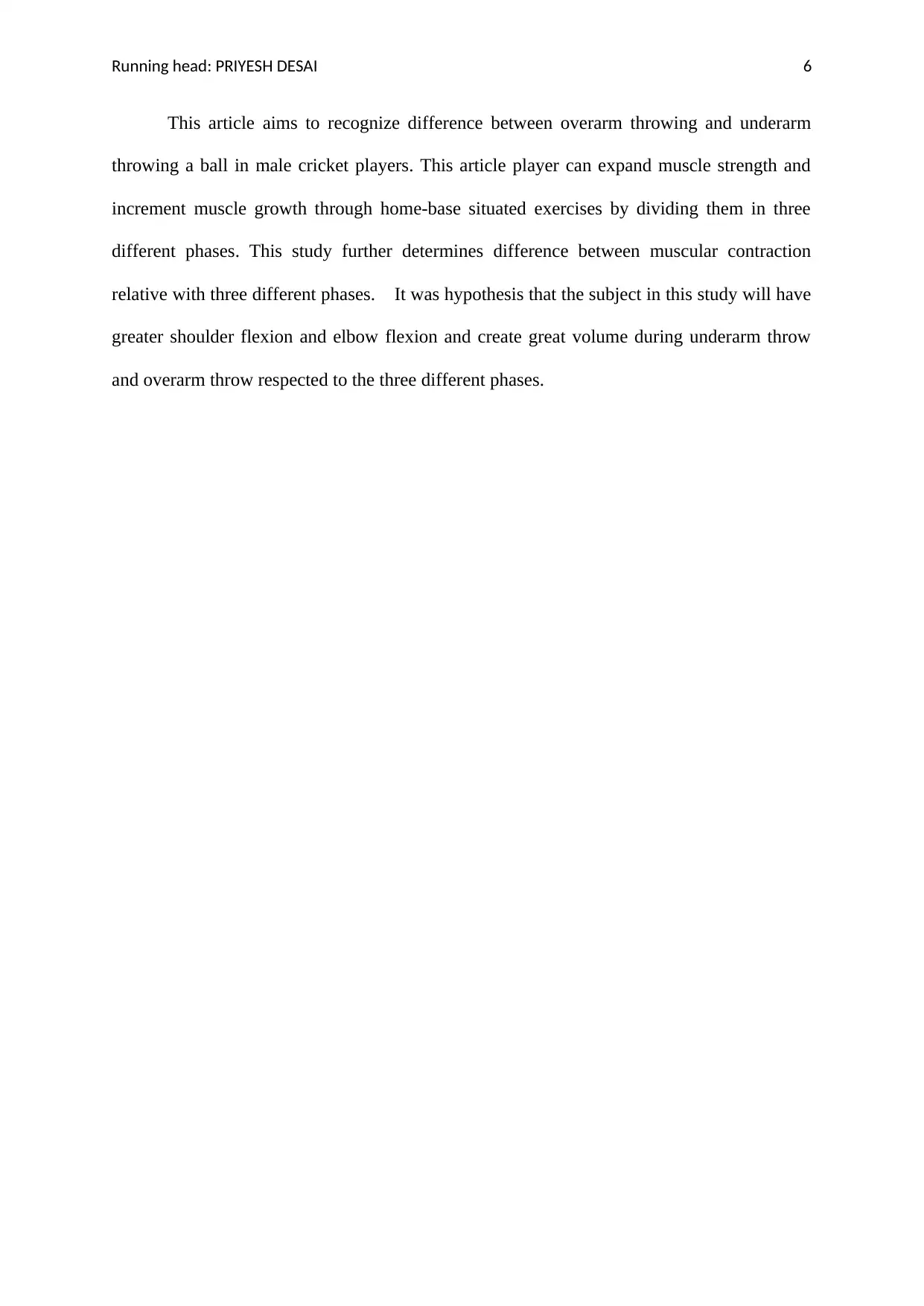
Running head: PRIYESH DESAI 6
This article aims to recognize difference between overarm throwing and underarm
throwing a ball in male cricket players. This article player can expand muscle strength and
increment muscle growth through home-base situated exercises by dividing them in three
different phases. This study further determines difference between muscular contraction
relative with three different phases. It was hypothesis that the subject in this study will have
greater shoulder flexion and elbow flexion and create great volume during underarm throw
and overarm throw respected to the three different phases.
This article aims to recognize difference between overarm throwing and underarm
throwing a ball in male cricket players. This article player can expand muscle strength and
increment muscle growth through home-base situated exercises by dividing them in three
different phases. This study further determines difference between muscular contraction
relative with three different phases. It was hypothesis that the subject in this study will have
greater shoulder flexion and elbow flexion and create great volume during underarm throw
and overarm throw respected to the three different phases.
Paraphrase This Document
Need a fresh take? Get an instant paraphrase of this document with our AI Paraphraser
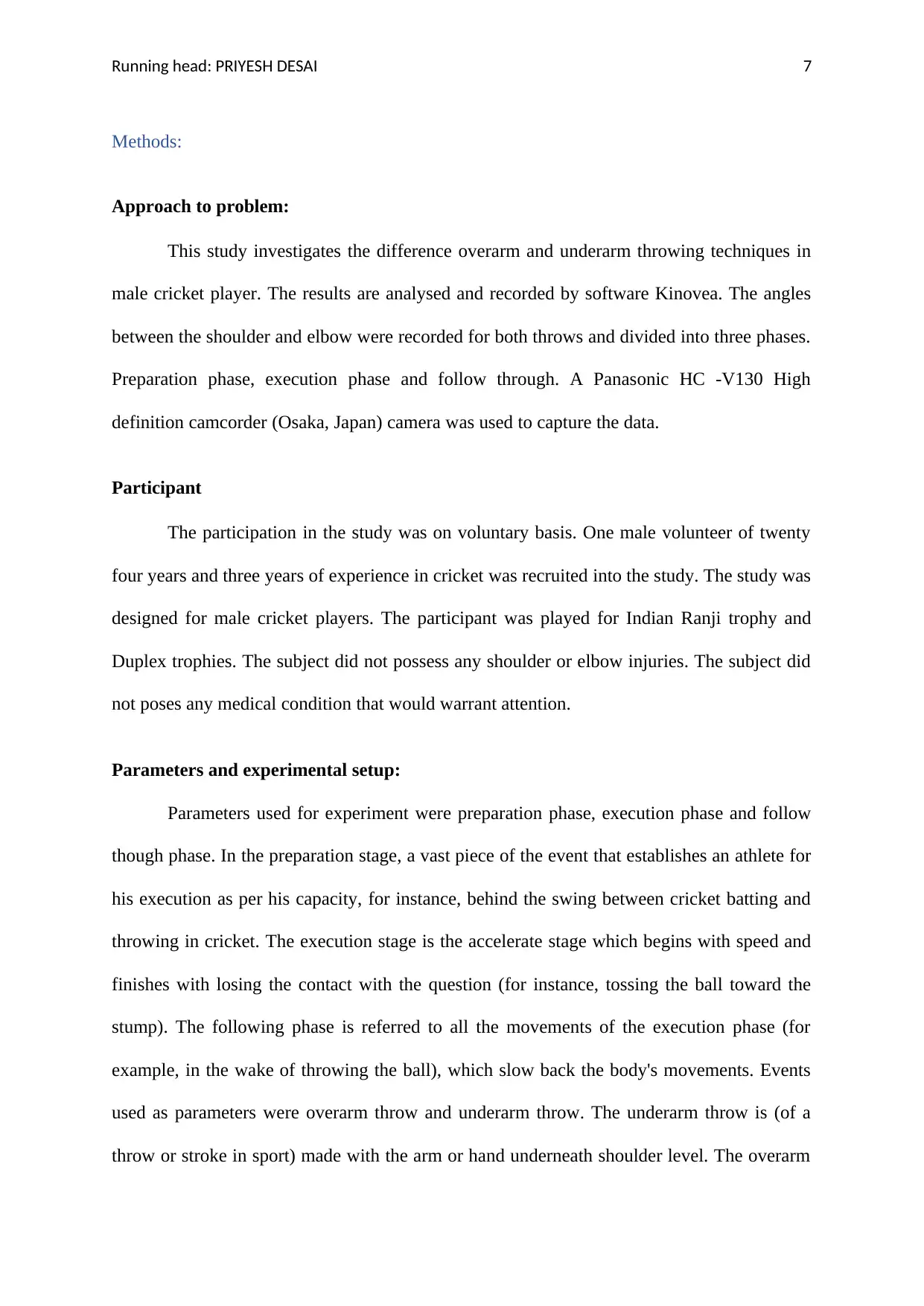
Running head: PRIYESH DESAI 7
Methods:
Approach to problem:
This study investigates the difference overarm and underarm throwing techniques in
male cricket player. The results are analysed and recorded by software Kinovea. The angles
between the shoulder and elbow were recorded for both throws and divided into three phases.
Preparation phase, execution phase and follow through. A Panasonic HC -V130 High
definition camcorder (Osaka, Japan) camera was used to capture the data.
Participant
The participation in the study was on voluntary basis. One male volunteer of twenty
four years and three years of experience in cricket was recruited into the study. The study was
designed for male cricket players. The participant was played for Indian Ranji trophy and
Duplex trophies. The subject did not possess any shoulder or elbow injuries. The subject did
not poses any medical condition that would warrant attention.
Parameters and experimental setup:
Parameters used for experiment were preparation phase, execution phase and follow
though phase. In the preparation stage, a vast piece of the event that establishes an athlete for
his execution as per his capacity, for instance, behind the swing between cricket batting and
throwing in cricket. The execution stage is the accelerate stage which begins with speed and
finishes with losing the contact with the question (for instance, tossing the ball toward the
stump). The following phase is referred to all the movements of the execution phase (for
example, in the wake of throwing the ball), which slow back the body's movements. Events
used as parameters were overarm throw and underarm throw. The underarm throw is (of a
throw or stroke in sport) made with the arm or hand underneath shoulder level. The overarm
Methods:
Approach to problem:
This study investigates the difference overarm and underarm throwing techniques in
male cricket player. The results are analysed and recorded by software Kinovea. The angles
between the shoulder and elbow were recorded for both throws and divided into three phases.
Preparation phase, execution phase and follow through. A Panasonic HC -V130 High
definition camcorder (Osaka, Japan) camera was used to capture the data.
Participant
The participation in the study was on voluntary basis. One male volunteer of twenty
four years and three years of experience in cricket was recruited into the study. The study was
designed for male cricket players. The participant was played for Indian Ranji trophy and
Duplex trophies. The subject did not possess any shoulder or elbow injuries. The subject did
not poses any medical condition that would warrant attention.
Parameters and experimental setup:
Parameters used for experiment were preparation phase, execution phase and follow
though phase. In the preparation stage, a vast piece of the event that establishes an athlete for
his execution as per his capacity, for instance, behind the swing between cricket batting and
throwing in cricket. The execution stage is the accelerate stage which begins with speed and
finishes with losing the contact with the question (for instance, tossing the ball toward the
stump). The following phase is referred to all the movements of the execution phase (for
example, in the wake of throwing the ball), which slow back the body's movements. Events
used as parameters were overarm throw and underarm throw. The underarm throw is (of a
throw or stroke in sport) made with the arm or hand underneath shoulder level. The overarm
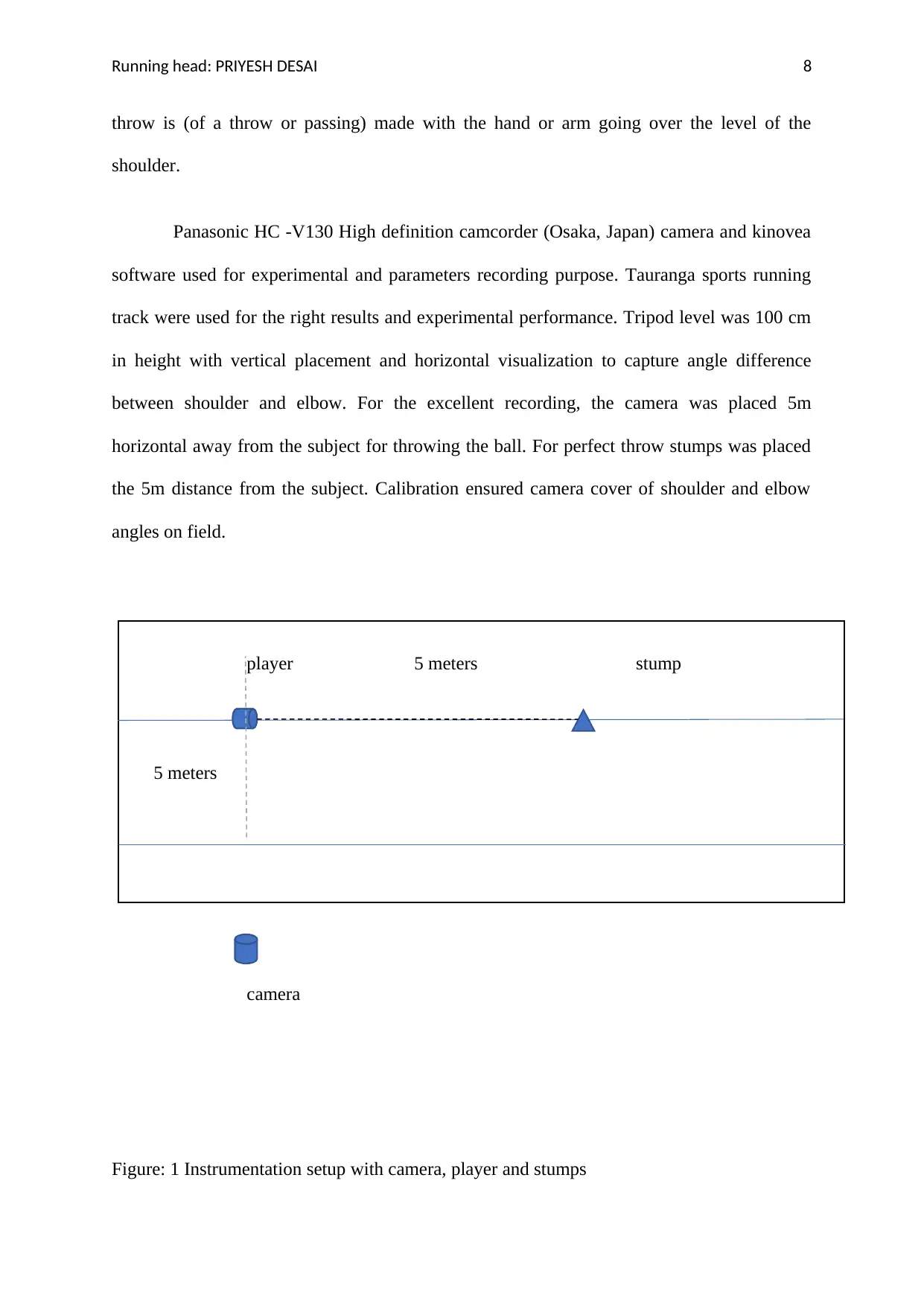
Running head: PRIYESH DESAI 8
throw is (of a throw or passing) made with the hand or arm going over the level of the
shoulder.
Panasonic HC -V130 High definition camcorder (Osaka, Japan) camera and kinovea
software used for experimental and parameters recording purpose. Tauranga sports running
track were used for the right results and experimental performance. Tripod level was 100 cm
in height with vertical placement and horizontal visualization to capture angle difference
between shoulder and elbow. For the excellent recording, the camera was placed 5m
horizontal away from the subject for throwing the ball. For perfect throw stumps was placed
the 5m distance from the subject. Calibration ensured camera cover of shoulder and elbow
angles on field.
player 5 meters stump
5 meters
camera
Figure: 1 Instrumentation setup with camera, player and stumps
throw is (of a throw or passing) made with the hand or arm going over the level of the
shoulder.
Panasonic HC -V130 High definition camcorder (Osaka, Japan) camera and kinovea
software used for experimental and parameters recording purpose. Tauranga sports running
track were used for the right results and experimental performance. Tripod level was 100 cm
in height with vertical placement and horizontal visualization to capture angle difference
between shoulder and elbow. For the excellent recording, the camera was placed 5m
horizontal away from the subject for throwing the ball. For perfect throw stumps was placed
the 5m distance from the subject. Calibration ensured camera cover of shoulder and elbow
angles on field.
player 5 meters stump
5 meters
camera
Figure: 1 Instrumentation setup with camera, player and stumps
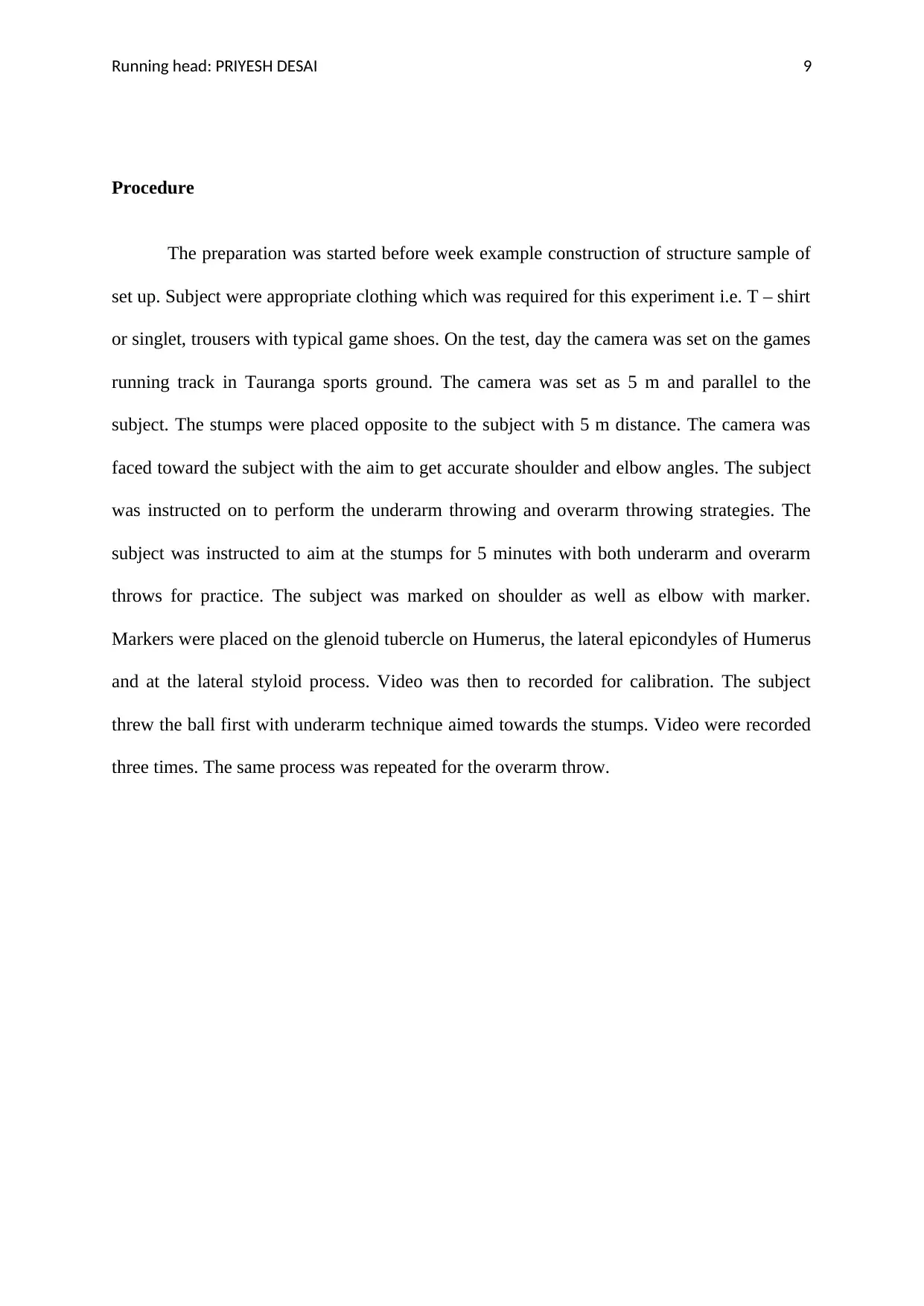
Running head: PRIYESH DESAI 9
Procedure
The preparation was started before week example construction of structure sample of
set up. Subject were appropriate clothing which was required for this experiment i.e. T – shirt
or singlet, trousers with typical game shoes. On the test, day the camera was set on the games
running track in Tauranga sports ground. The camera was set as 5 m and parallel to the
subject. The stumps were placed opposite to the subject with 5 m distance. The camera was
faced toward the subject with the aim to get accurate shoulder and elbow angles. The subject
was instructed on to perform the underarm throwing and overarm throwing strategies. The
subject was instructed to aim at the stumps for 5 minutes with both underarm and overarm
throws for practice. The subject was marked on shoulder as well as elbow with marker.
Markers were placed on the glenoid tubercle on Humerus, the lateral epicondyles of Humerus
and at the lateral styloid process. Video was then to recorded for calibration. The subject
threw the ball first with underarm technique aimed towards the stumps. Video were recorded
three times. The same process was repeated for the overarm throw.
Procedure
The preparation was started before week example construction of structure sample of
set up. Subject were appropriate clothing which was required for this experiment i.e. T – shirt
or singlet, trousers with typical game shoes. On the test, day the camera was set on the games
running track in Tauranga sports ground. The camera was set as 5 m and parallel to the
subject. The stumps were placed opposite to the subject with 5 m distance. The camera was
faced toward the subject with the aim to get accurate shoulder and elbow angles. The subject
was instructed on to perform the underarm throwing and overarm throwing strategies. The
subject was instructed to aim at the stumps for 5 minutes with both underarm and overarm
throws for practice. The subject was marked on shoulder as well as elbow with marker.
Markers were placed on the glenoid tubercle on Humerus, the lateral epicondyles of Humerus
and at the lateral styloid process. Video was then to recorded for calibration. The subject
threw the ball first with underarm technique aimed towards the stumps. Video were recorded
three times. The same process was repeated for the overarm throw.
Secure Best Marks with AI Grader
Need help grading? Try our AI Grader for instant feedback on your assignments.
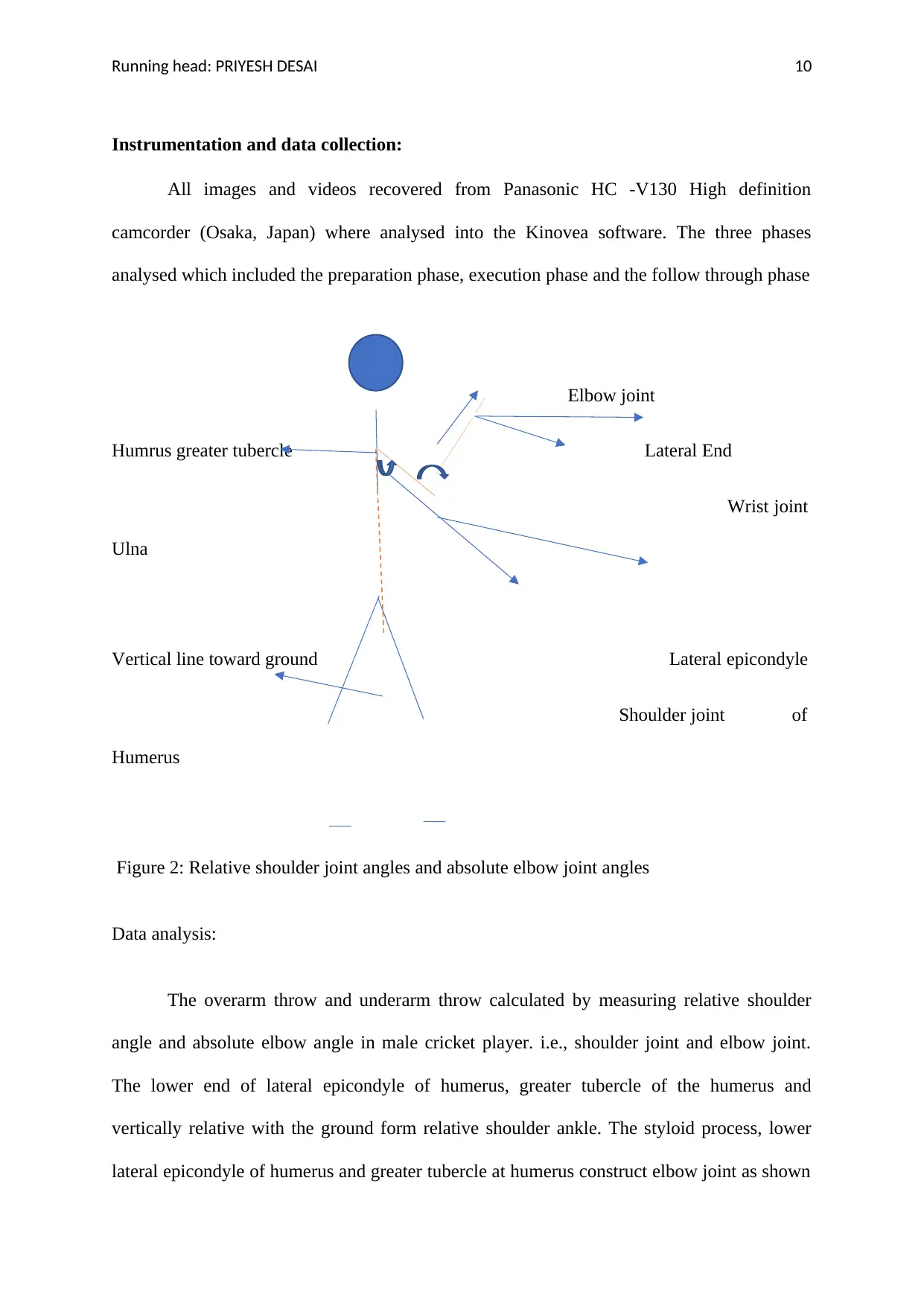
Running head: PRIYESH DESAI 10
Instrumentation and data collection:
All images and videos recovered from Panasonic HC -V130 High definition
camcorder (Osaka, Japan) where analysed into the Kinovea software. The three phases
analysed which included the preparation phase, execution phase and the follow through phase
Elbow joint
Humrus greater tubercle Lateral End
Wrist joint
Ulna
Vertical line toward ground Lateral epicondyle
Shoulder joint of
Humerus
Figure 2: Relative shoulder joint angles and absolute elbow joint angles
Data analysis:
The overarm throw and underarm throw calculated by measuring relative shoulder
angle and absolute elbow angle in male cricket player. i.e., shoulder joint and elbow joint.
The lower end of lateral epicondyle of humerus, greater tubercle of the humerus and
vertically relative with the ground form relative shoulder ankle. The styloid process, lower
lateral epicondyle of humerus and greater tubercle at humerus construct elbow joint as shown
Instrumentation and data collection:
All images and videos recovered from Panasonic HC -V130 High definition
camcorder (Osaka, Japan) where analysed into the Kinovea software. The three phases
analysed which included the preparation phase, execution phase and the follow through phase
Elbow joint
Humrus greater tubercle Lateral End
Wrist joint
Ulna
Vertical line toward ground Lateral epicondyle
Shoulder joint of
Humerus
Figure 2: Relative shoulder joint angles and absolute elbow joint angles
Data analysis:
The overarm throw and underarm throw calculated by measuring relative shoulder
angle and absolute elbow angle in male cricket player. i.e., shoulder joint and elbow joint.
The lower end of lateral epicondyle of humerus, greater tubercle of the humerus and
vertically relative with the ground form relative shoulder ankle. The styloid process, lower
lateral epicondyle of humerus and greater tubercle at humerus construct elbow joint as shown
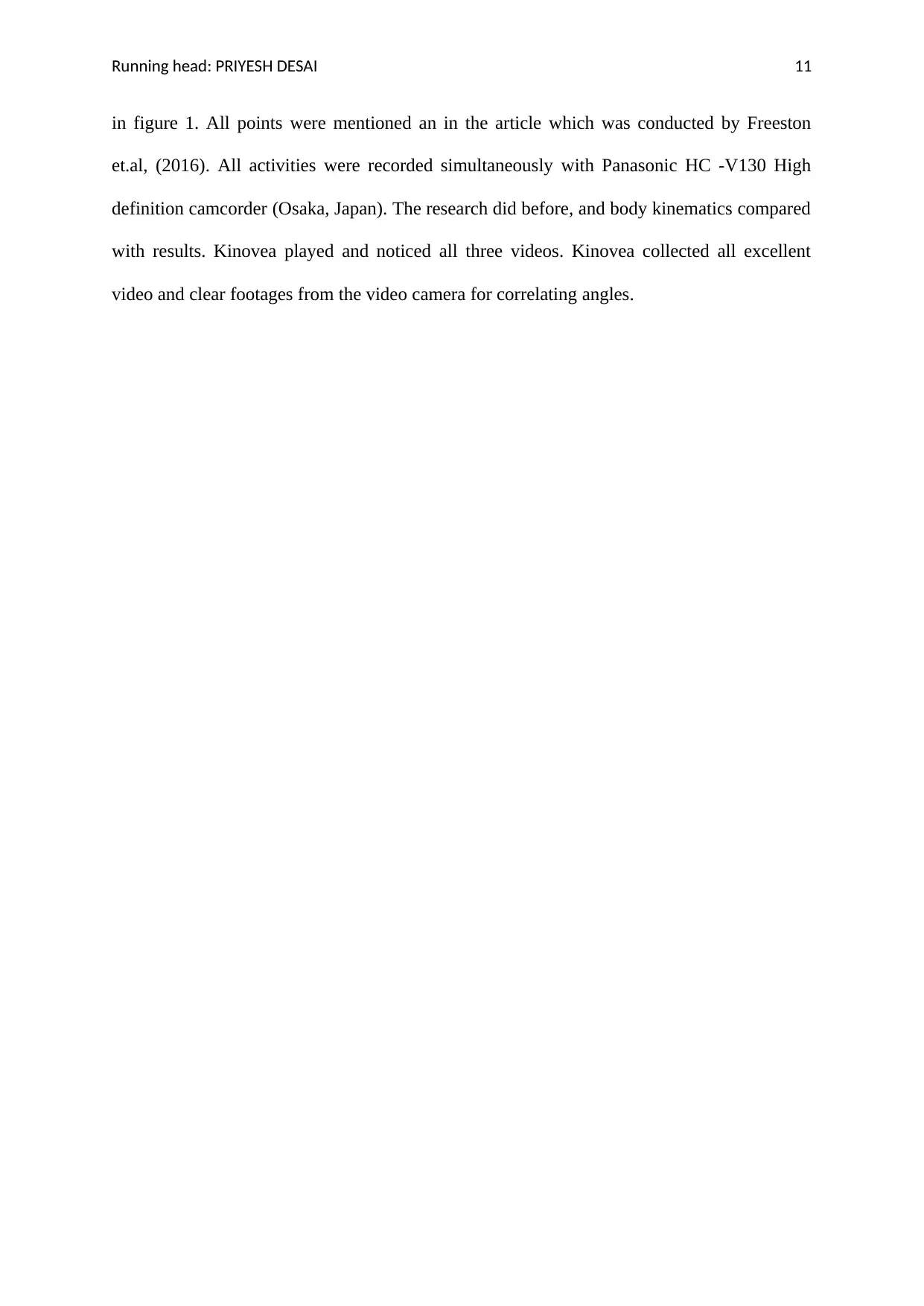
Running head: PRIYESH DESAI 11
in figure 1. All points were mentioned an in the article which was conducted by Freeston
et.al, (2016). All activities were recorded simultaneously with Panasonic HC -V130 High
definition camcorder (Osaka, Japan). The research did before, and body kinematics compared
with results. Kinovea played and noticed all three videos. Kinovea collected all excellent
video and clear footages from the video camera for correlating angles.
in figure 1. All points were mentioned an in the article which was conducted by Freeston
et.al, (2016). All activities were recorded simultaneously with Panasonic HC -V130 High
definition camcorder (Osaka, Japan). The research did before, and body kinematics compared
with results. Kinovea played and noticed all three videos. Kinovea collected all excellent
video and clear footages from the video camera for correlating angles.
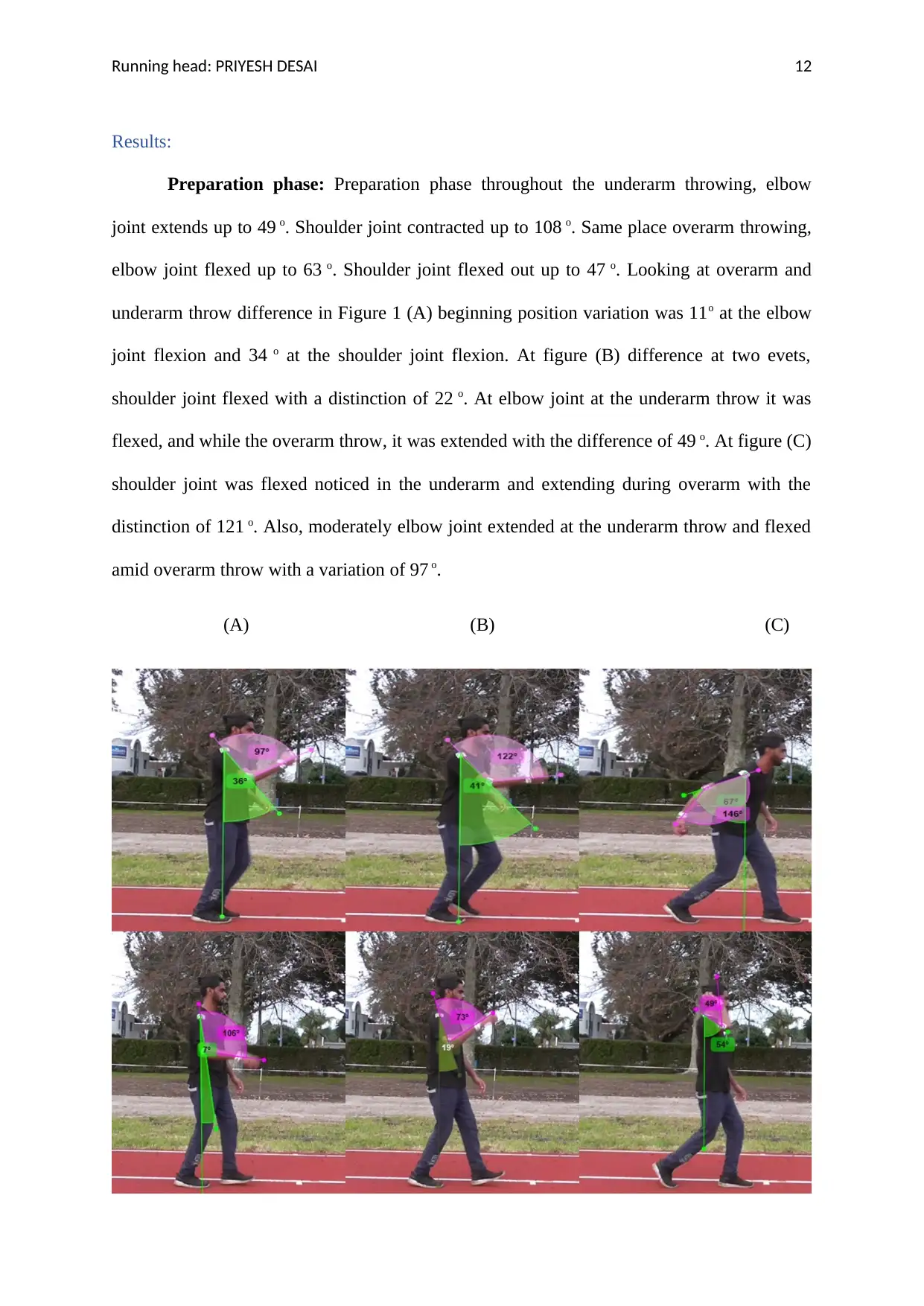
Running head: PRIYESH DESAI 12
Results:
Preparation phase: Preparation phase throughout the underarm throwing, elbow
joint extends up to 49 o. Shoulder joint contracted up to 108 o. Same place overarm throwing,
elbow joint flexed up to 63 o. Shoulder joint flexed out up to 47 o. Looking at overarm and
underarm throw difference in Figure 1 (A) beginning position variation was 11o at the elbow
joint flexion and 34 o at the shoulder joint flexion. At figure (B) difference at two evets,
shoulder joint flexed with a distinction of 22 o. At elbow joint at the underarm throw it was
flexed, and while the overarm throw, it was extended with the difference of 49 o. At figure (C)
shoulder joint was flexed noticed in the underarm and extending during overarm with the
distinction of 121 o. Also, moderately elbow joint extended at the underarm throw and flexed
amid overarm throw with a variation of 97 o.
(A) (B) (C)
Results:
Preparation phase: Preparation phase throughout the underarm throwing, elbow
joint extends up to 49 o. Shoulder joint contracted up to 108 o. Same place overarm throwing,
elbow joint flexed up to 63 o. Shoulder joint flexed out up to 47 o. Looking at overarm and
underarm throw difference in Figure 1 (A) beginning position variation was 11o at the elbow
joint flexion and 34 o at the shoulder joint flexion. At figure (B) difference at two evets,
shoulder joint flexed with a distinction of 22 o. At elbow joint at the underarm throw it was
flexed, and while the overarm throw, it was extended with the difference of 49 o. At figure (C)
shoulder joint was flexed noticed in the underarm and extending during overarm with the
distinction of 121 o. Also, moderately elbow joint extended at the underarm throw and flexed
amid overarm throw with a variation of 97 o.
(A) (B) (C)
Paraphrase This Document
Need a fresh take? Get an instant paraphrase of this document with our AI Paraphraser

Running head: PRIYESH DESAI 13
Figure 1: Preparation phase: Above underarm throw A, B and C figure left to right
Below overarm throw. A, B and C figure left to right
Figure 1: Preparation phase: Above underarm throw A, B and C figure left to right
Below overarm throw. A, B and C figure left to right
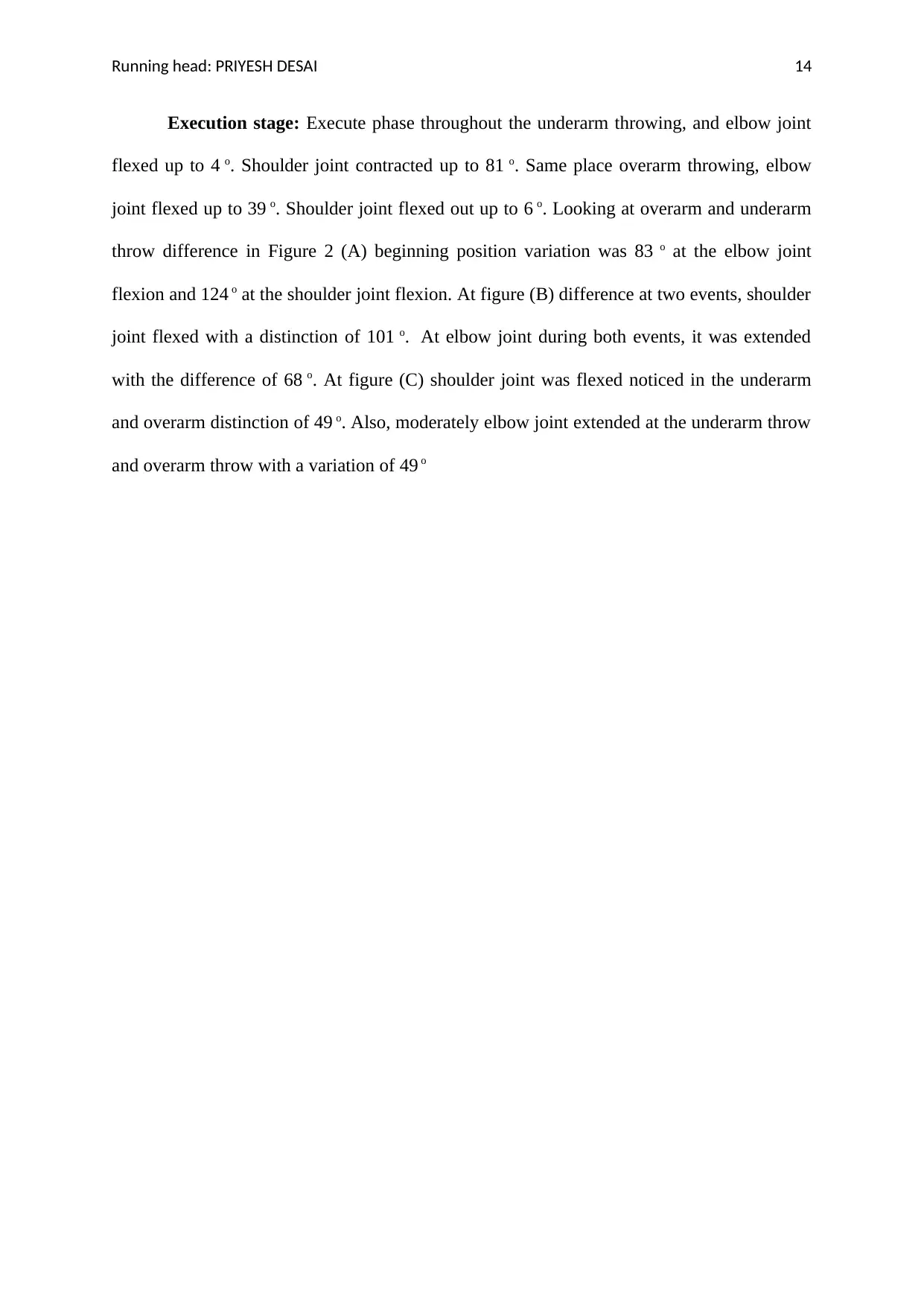
Running head: PRIYESH DESAI 14
Execution stage: Execute phase throughout the underarm throwing, and elbow joint
flexed up to 4 o. Shoulder joint contracted up to 81 o. Same place overarm throwing, elbow
joint flexed up to 39 o. Shoulder joint flexed out up to 6 o. Looking at overarm and underarm
throw difference in Figure 2 (A) beginning position variation was 83 o at the elbow joint
flexion and 124 o at the shoulder joint flexion. At figure (B) difference at two events, shoulder
joint flexed with a distinction of 101 o. At elbow joint during both events, it was extended
with the difference of 68 o. At figure (C) shoulder joint was flexed noticed in the underarm
and overarm distinction of 49 o. Also, moderately elbow joint extended at the underarm throw
and overarm throw with a variation of 49 o
Execution stage: Execute phase throughout the underarm throwing, and elbow joint
flexed up to 4 o. Shoulder joint contracted up to 81 o. Same place overarm throwing, elbow
joint flexed up to 39 o. Shoulder joint flexed out up to 6 o. Looking at overarm and underarm
throw difference in Figure 2 (A) beginning position variation was 83 o at the elbow joint
flexion and 124 o at the shoulder joint flexion. At figure (B) difference at two events, shoulder
joint flexed with a distinction of 101 o. At elbow joint during both events, it was extended
with the difference of 68 o. At figure (C) shoulder joint was flexed noticed in the underarm
and overarm distinction of 49 o. Also, moderately elbow joint extended at the underarm throw
and overarm throw with a variation of 49 o
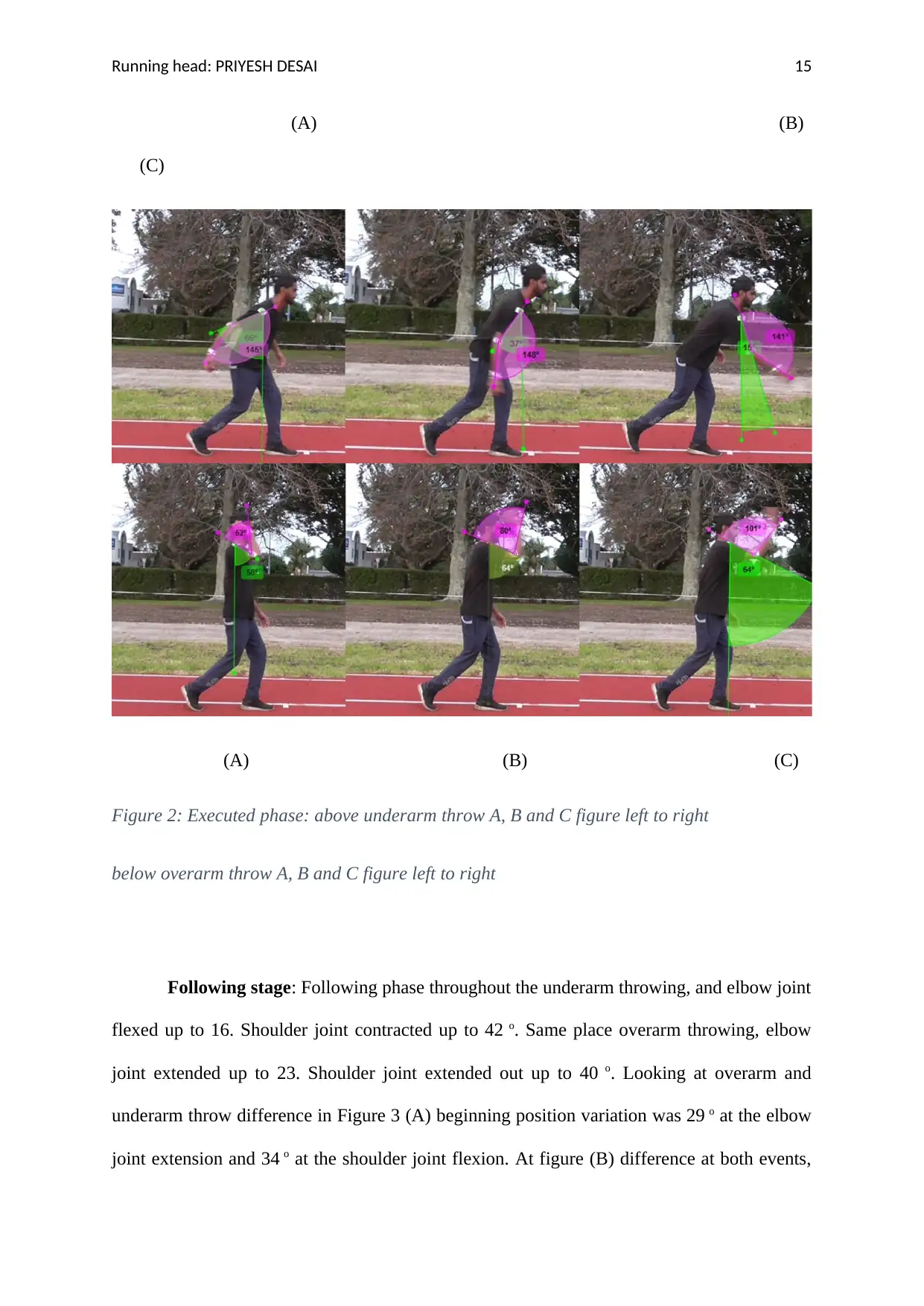
Running head: PRIYESH DESAI 15
(A) (B)
(C)
(A) (B) (C)
Figure 2: Executed phase: above underarm throw A, B and C figure left to right
below overarm throw A, B and C figure left to right
Following stage: Following phase throughout the underarm throwing, and elbow joint
flexed up to 16. Shoulder joint contracted up to 42 o. Same place overarm throwing, elbow
joint extended up to 23. Shoulder joint extended out up to 40 o. Looking at overarm and
underarm throw difference in Figure 3 (A) beginning position variation was 29 o at the elbow
joint extension and 34 o at the shoulder joint flexion. At figure (B) difference at both events,
(A) (B)
(C)
(A) (B) (C)
Figure 2: Executed phase: above underarm throw A, B and C figure left to right
below overarm throw A, B and C figure left to right
Following stage: Following phase throughout the underarm throwing, and elbow joint
flexed up to 16. Shoulder joint contracted up to 42 o. Same place overarm throwing, elbow
joint extended up to 23. Shoulder joint extended out up to 40 o. Looking at overarm and
underarm throw difference in Figure 3 (A) beginning position variation was 29 o at the elbow
joint extension and 34 o at the shoulder joint flexion. At figure (B) difference at both events,
Secure Best Marks with AI Grader
Need help grading? Try our AI Grader for instant feedback on your assignments.
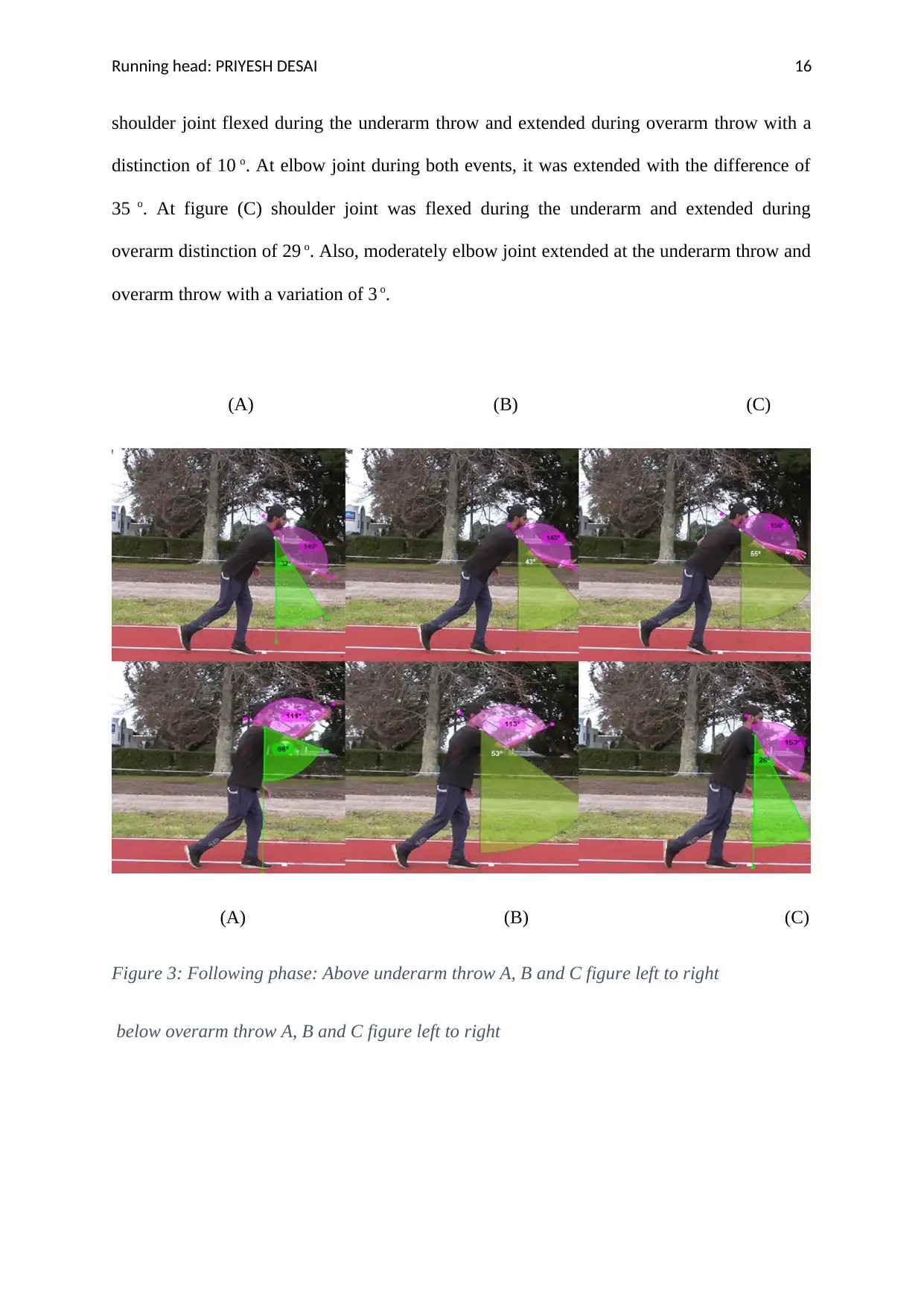
Running head: PRIYESH DESAI 16
shoulder joint flexed during the underarm throw and extended during overarm throw with a
distinction of 10 o. At elbow joint during both events, it was extended with the difference of
35 o. At figure (C) shoulder joint was flexed during the underarm and extended during
overarm distinction of 29 o. Also, moderately elbow joint extended at the underarm throw and
overarm throw with a variation of 3 o.
(A) (B) (C)
(A) (B) (C)
Figure 3: Following phase: Above underarm throw A, B and C figure left to right
below overarm throw A, B and C figure left to right
shoulder joint flexed during the underarm throw and extended during overarm throw with a
distinction of 10 o. At elbow joint during both events, it was extended with the difference of
35 o. At figure (C) shoulder joint was flexed during the underarm and extended during
overarm distinction of 29 o. Also, moderately elbow joint extended at the underarm throw and
overarm throw with a variation of 3 o.
(A) (B) (C)
(A) (B) (C)
Figure 3: Following phase: Above underarm throw A, B and C figure left to right
below overarm throw A, B and C figure left to right
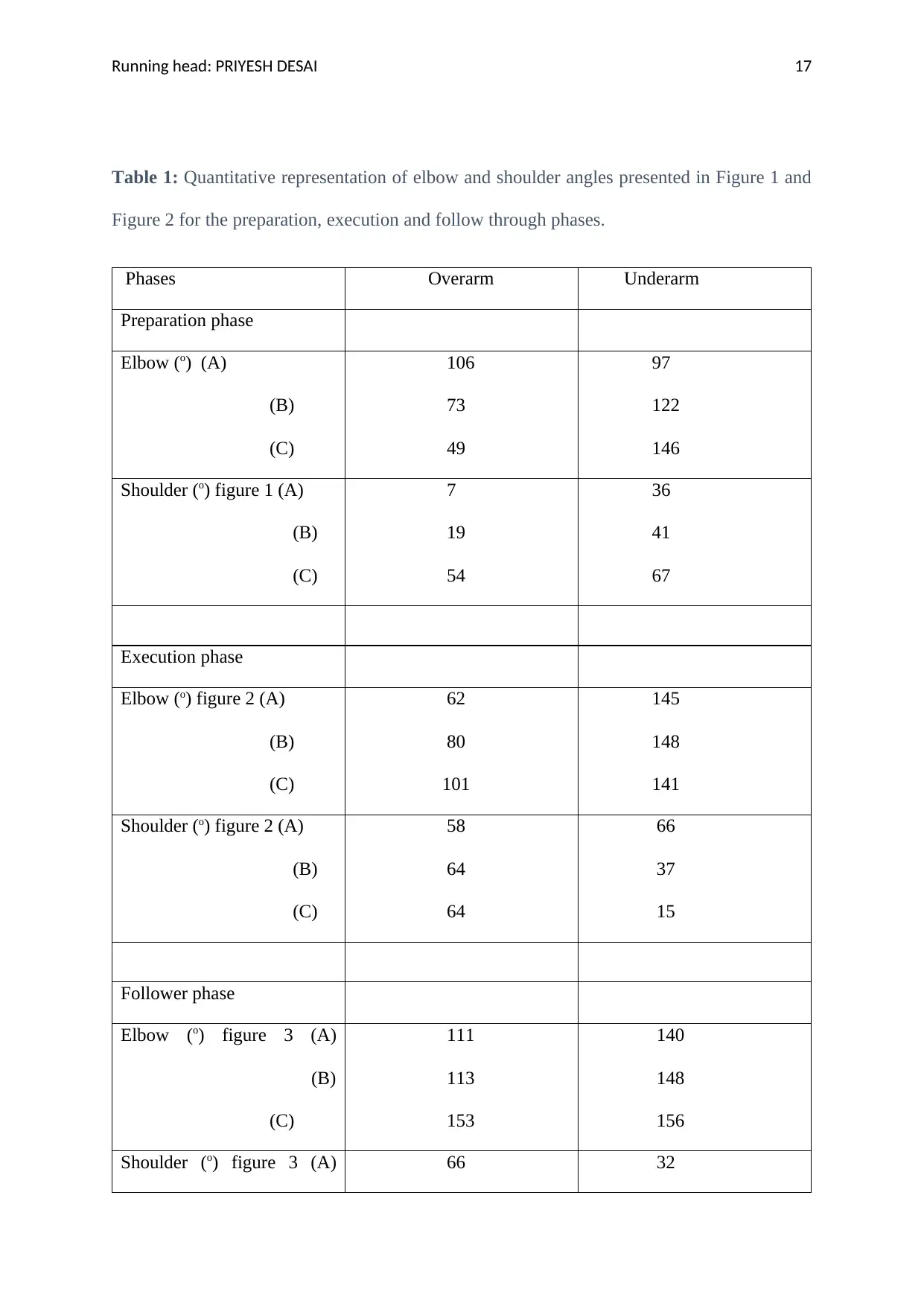
Running head: PRIYESH DESAI 17
Table 1: Quantitative representation of elbow and shoulder angles presented in Figure 1 and
Figure 2 for the preparation, execution and follow through phases.
Phases Overarm Underarm
Preparation phase
Elbow (o) (A)
(B)
(C)
106
73
49
97
122
146
Shoulder (o) figure 1 (A)
(B)
(C)
7
19
54
36
41
67
Execution phase
Elbow (o) figure 2 (A)
(B)
(C)
62
80
101
145
148
141
Shoulder (o) figure 2 (A)
(B)
(C)
58
64
64
66
37
15
Follower phase
Elbow (o) figure 3 (A)
(B)
(C)
111
113
153
140
148
156
Shoulder (o) figure 3 (A) 66 32
Table 1: Quantitative representation of elbow and shoulder angles presented in Figure 1 and
Figure 2 for the preparation, execution and follow through phases.
Phases Overarm Underarm
Preparation phase
Elbow (o) (A)
(B)
(C)
106
73
49
97
122
146
Shoulder (o) figure 1 (A)
(B)
(C)
7
19
54
36
41
67
Execution phase
Elbow (o) figure 2 (A)
(B)
(C)
62
80
101
145
148
141
Shoulder (o) figure 2 (A)
(B)
(C)
58
64
64
66
37
15
Follower phase
Elbow (o) figure 3 (A)
(B)
(C)
111
113
153
140
148
156
Shoulder (o) figure 3 (A) 66 32
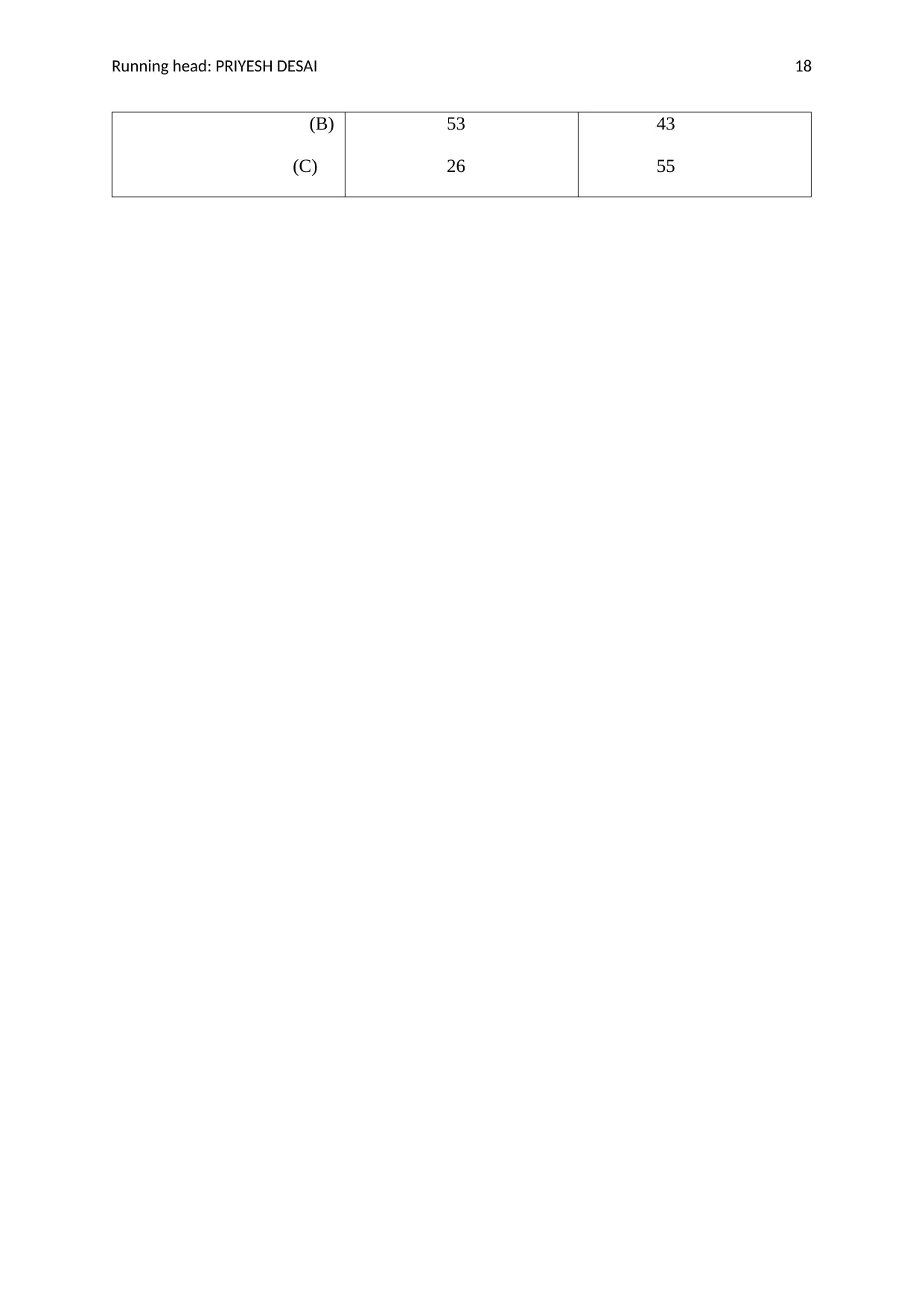
Running head: PRIYESH DESAI 18
(B)
(C)
53
26
43
55
(B)
(C)
53
26
43
55
Paraphrase This Document
Need a fresh take? Get an instant paraphrase of this document with our AI Paraphraser
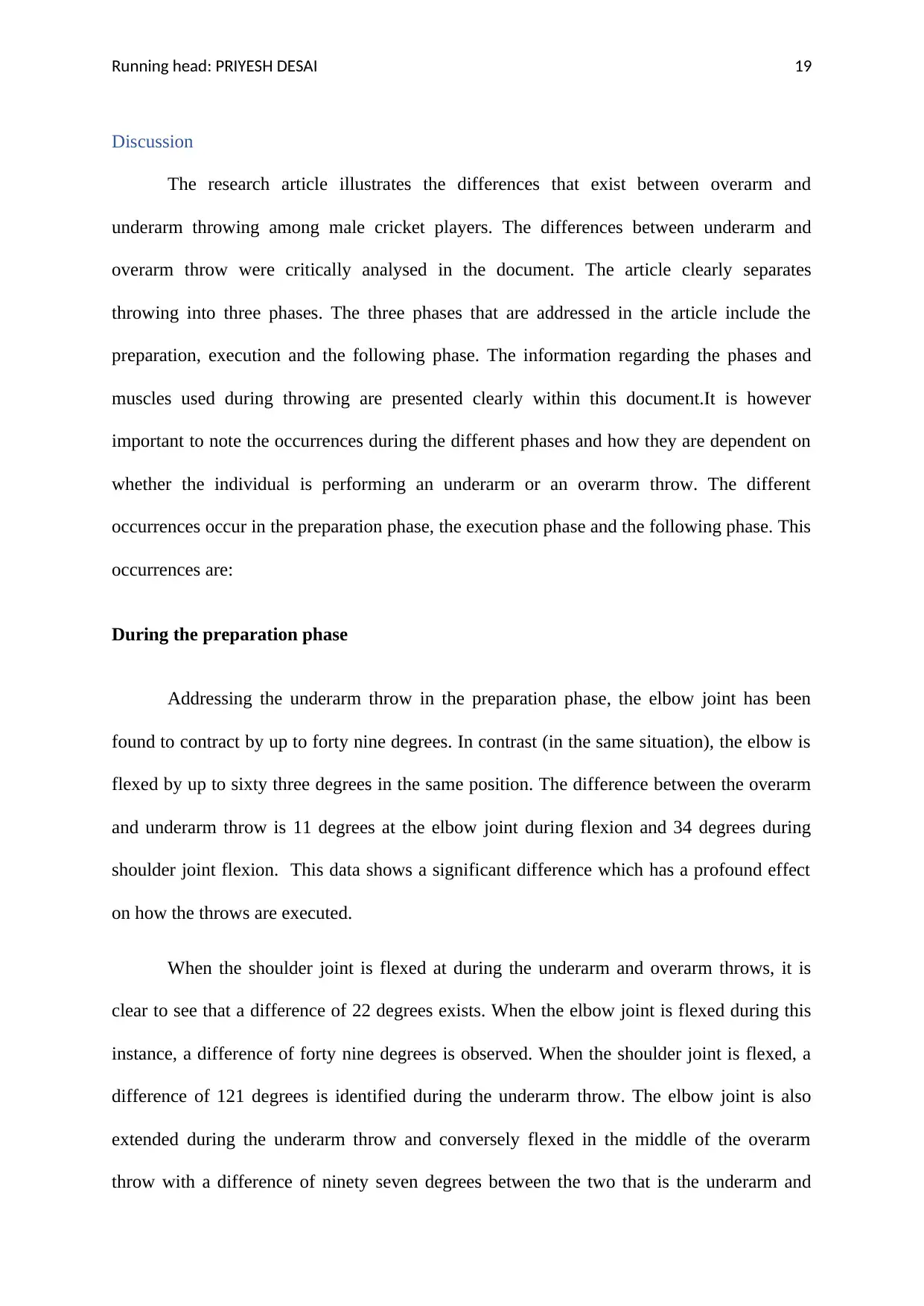
Running head: PRIYESH DESAI 19
Discussion
The research article illustrates the differences that exist between overarm and
underarm throwing among male cricket players. The differences between underarm and
overarm throw were critically analysed in the document. The article clearly separates
throwing into three phases. The three phases that are addressed in the article include the
preparation, execution and the following phase. The information regarding the phases and
muscles used during throwing are presented clearly within this document.It is however
important to note the occurrences during the different phases and how they are dependent on
whether the individual is performing an underarm or an overarm throw. The different
occurrences occur in the preparation phase, the execution phase and the following phase. This
occurrences are:
During the preparation phase
Addressing the underarm throw in the preparation phase, the elbow joint has been
found to contract by up to forty nine degrees. In contrast (in the same situation), the elbow is
flexed by up to sixty three degrees in the same position. The difference between the overarm
and underarm throw is 11 degrees at the elbow joint during flexion and 34 degrees during
shoulder joint flexion. This data shows a significant difference which has a profound effect
on how the throws are executed.
When the shoulder joint is flexed at during the underarm and overarm throws, it is
clear to see that a difference of 22 degrees exists. When the elbow joint is flexed during this
instance, a difference of forty nine degrees is observed. When the shoulder joint is flexed, a
difference of 121 degrees is identified during the underarm throw. The elbow joint is also
extended during the underarm throw and conversely flexed in the middle of the overarm
throw with a difference of ninety seven degrees between the two that is the underarm and
Discussion
The research article illustrates the differences that exist between overarm and
underarm throwing among male cricket players. The differences between underarm and
overarm throw were critically analysed in the document. The article clearly separates
throwing into three phases. The three phases that are addressed in the article include the
preparation, execution and the following phase. The information regarding the phases and
muscles used during throwing are presented clearly within this document.It is however
important to note the occurrences during the different phases and how they are dependent on
whether the individual is performing an underarm or an overarm throw. The different
occurrences occur in the preparation phase, the execution phase and the following phase. This
occurrences are:
During the preparation phase
Addressing the underarm throw in the preparation phase, the elbow joint has been
found to contract by up to forty nine degrees. In contrast (in the same situation), the elbow is
flexed by up to sixty three degrees in the same position. The difference between the overarm
and underarm throw is 11 degrees at the elbow joint during flexion and 34 degrees during
shoulder joint flexion. This data shows a significant difference which has a profound effect
on how the throws are executed.
When the shoulder joint is flexed at during the underarm and overarm throws, it is
clear to see that a difference of 22 degrees exists. When the elbow joint is flexed during this
instance, a difference of forty nine degrees is observed. When the shoulder joint is flexed, a
difference of 121 degrees is identified during the underarm throw. The elbow joint is also
extended during the underarm throw and conversely flexed in the middle of the overarm
throw with a difference of ninety seven degrees between the two that is the underarm and
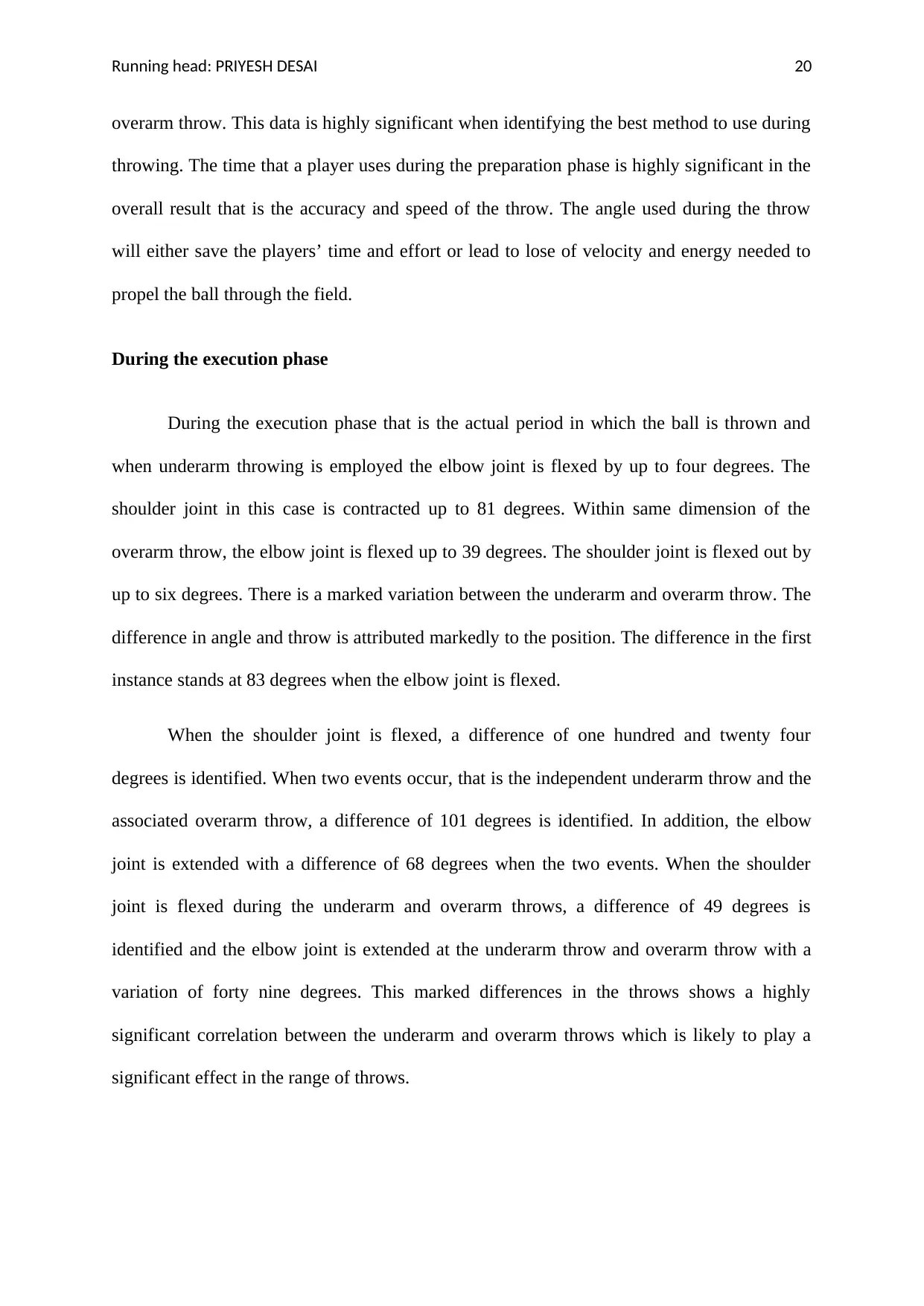
Running head: PRIYESH DESAI 20
overarm throw. This data is highly significant when identifying the best method to use during
throwing. The time that a player uses during the preparation phase is highly significant in the
overall result that is the accuracy and speed of the throw. The angle used during the throw
will either save the players’ time and effort or lead to lose of velocity and energy needed to
propel the ball through the field.
During the execution phase
During the execution phase that is the actual period in which the ball is thrown and
when underarm throwing is employed the elbow joint is flexed by up to four degrees. The
shoulder joint in this case is contracted up to 81 degrees. Within same dimension of the
overarm throw, the elbow joint is flexed up to 39 degrees. The shoulder joint is flexed out by
up to six degrees. There is a marked variation between the underarm and overarm throw. The
difference in angle and throw is attributed markedly to the position. The difference in the first
instance stands at 83 degrees when the elbow joint is flexed.
When the shoulder joint is flexed, a difference of one hundred and twenty four
degrees is identified. When two events occur, that is the independent underarm throw and the
associated overarm throw, a difference of 101 degrees is identified. In addition, the elbow
joint is extended with a difference of 68 degrees when the two events. When the shoulder
joint is flexed during the underarm and overarm throws, a difference of 49 degrees is
identified and the elbow joint is extended at the underarm throw and overarm throw with a
variation of forty nine degrees. This marked differences in the throws shows a highly
significant correlation between the underarm and overarm throws which is likely to play a
significant effect in the range of throws.
overarm throw. This data is highly significant when identifying the best method to use during
throwing. The time that a player uses during the preparation phase is highly significant in the
overall result that is the accuracy and speed of the throw. The angle used during the throw
will either save the players’ time and effort or lead to lose of velocity and energy needed to
propel the ball through the field.
During the execution phase
During the execution phase that is the actual period in which the ball is thrown and
when underarm throwing is employed the elbow joint is flexed by up to four degrees. The
shoulder joint in this case is contracted up to 81 degrees. Within same dimension of the
overarm throw, the elbow joint is flexed up to 39 degrees. The shoulder joint is flexed out by
up to six degrees. There is a marked variation between the underarm and overarm throw. The
difference in angle and throw is attributed markedly to the position. The difference in the first
instance stands at 83 degrees when the elbow joint is flexed.
When the shoulder joint is flexed, a difference of one hundred and twenty four
degrees is identified. When two events occur, that is the independent underarm throw and the
associated overarm throw, a difference of 101 degrees is identified. In addition, the elbow
joint is extended with a difference of 68 degrees when the two events. When the shoulder
joint is flexed during the underarm and overarm throws, a difference of 49 degrees is
identified and the elbow joint is extended at the underarm throw and overarm throw with a
variation of forty nine degrees. This marked differences in the throws shows a highly
significant correlation between the underarm and overarm throws which is likely to play a
significant effect in the range of throws.
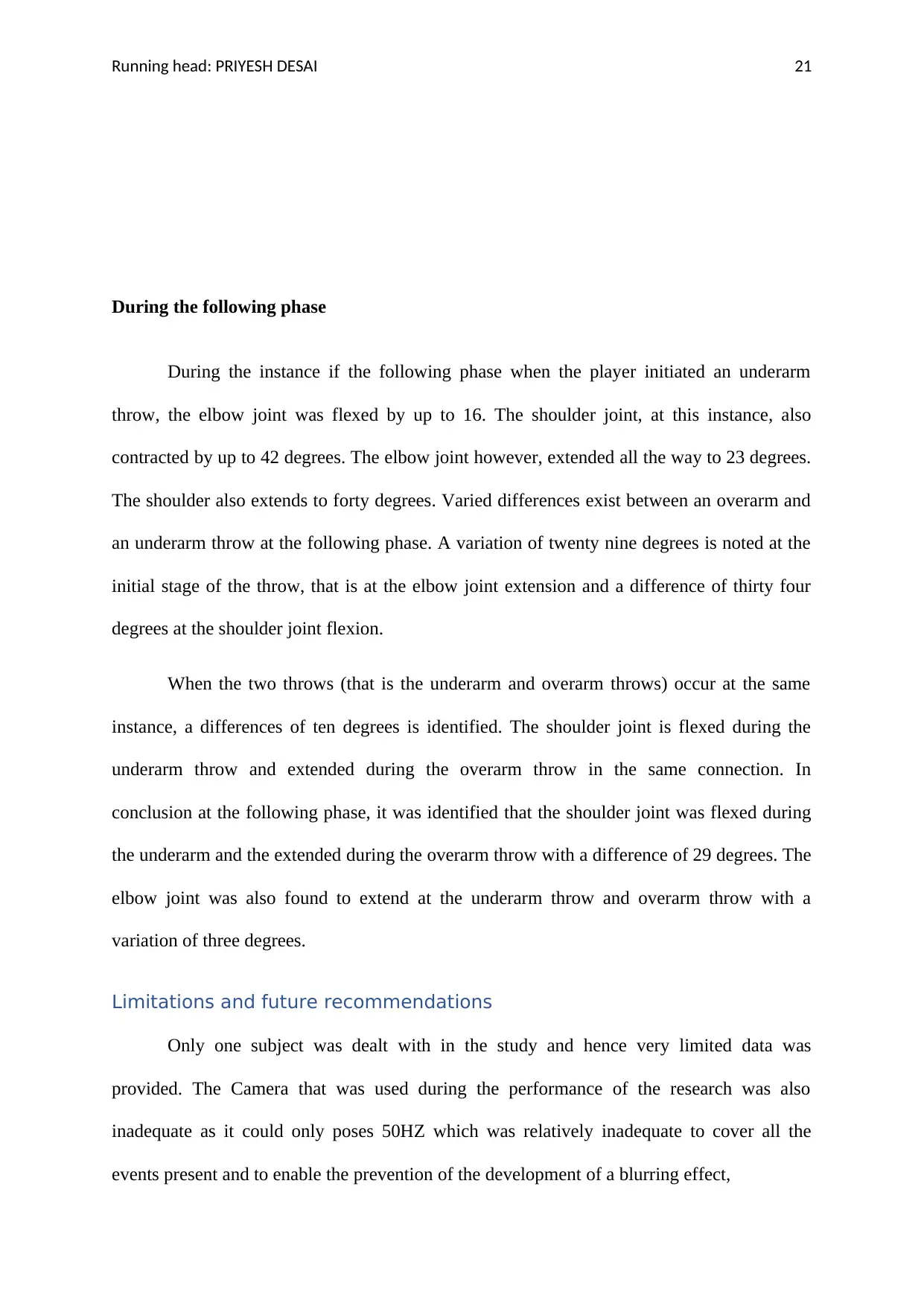
Running head: PRIYESH DESAI 21
During the following phase
During the instance if the following phase when the player initiated an underarm
throw, the elbow joint was flexed by up to 16. The shoulder joint, at this instance, also
contracted by up to 42 degrees. The elbow joint however, extended all the way to 23 degrees.
The shoulder also extends to forty degrees. Varied differences exist between an overarm and
an underarm throw at the following phase. A variation of twenty nine degrees is noted at the
initial stage of the throw, that is at the elbow joint extension and a difference of thirty four
degrees at the shoulder joint flexion.
When the two throws (that is the underarm and overarm throws) occur at the same
instance, a differences of ten degrees is identified. The shoulder joint is flexed during the
underarm throw and extended during the overarm throw in the same connection. In
conclusion at the following phase, it was identified that the shoulder joint was flexed during
the underarm and the extended during the overarm throw with a difference of 29 degrees. The
elbow joint was also found to extend at the underarm throw and overarm throw with a
variation of three degrees.
Limitations and future recommendations
Only one subject was dealt with in the study and hence very limited data was
provided. The Camera that was used during the performance of the research was also
inadequate as it could only poses 50HZ which was relatively inadequate to cover all the
events present and to enable the prevention of the development of a blurring effect,
During the following phase
During the instance if the following phase when the player initiated an underarm
throw, the elbow joint was flexed by up to 16. The shoulder joint, at this instance, also
contracted by up to 42 degrees. The elbow joint however, extended all the way to 23 degrees.
The shoulder also extends to forty degrees. Varied differences exist between an overarm and
an underarm throw at the following phase. A variation of twenty nine degrees is noted at the
initial stage of the throw, that is at the elbow joint extension and a difference of thirty four
degrees at the shoulder joint flexion.
When the two throws (that is the underarm and overarm throws) occur at the same
instance, a differences of ten degrees is identified. The shoulder joint is flexed during the
underarm throw and extended during the overarm throw in the same connection. In
conclusion at the following phase, it was identified that the shoulder joint was flexed during
the underarm and the extended during the overarm throw with a difference of 29 degrees. The
elbow joint was also found to extend at the underarm throw and overarm throw with a
variation of three degrees.
Limitations and future recommendations
Only one subject was dealt with in the study and hence very limited data was
provided. The Camera that was used during the performance of the research was also
inadequate as it could only poses 50HZ which was relatively inadequate to cover all the
events present and to enable the prevention of the development of a blurring effect,
Secure Best Marks with AI Grader
Need help grading? Try our AI Grader for instant feedback on your assignments.
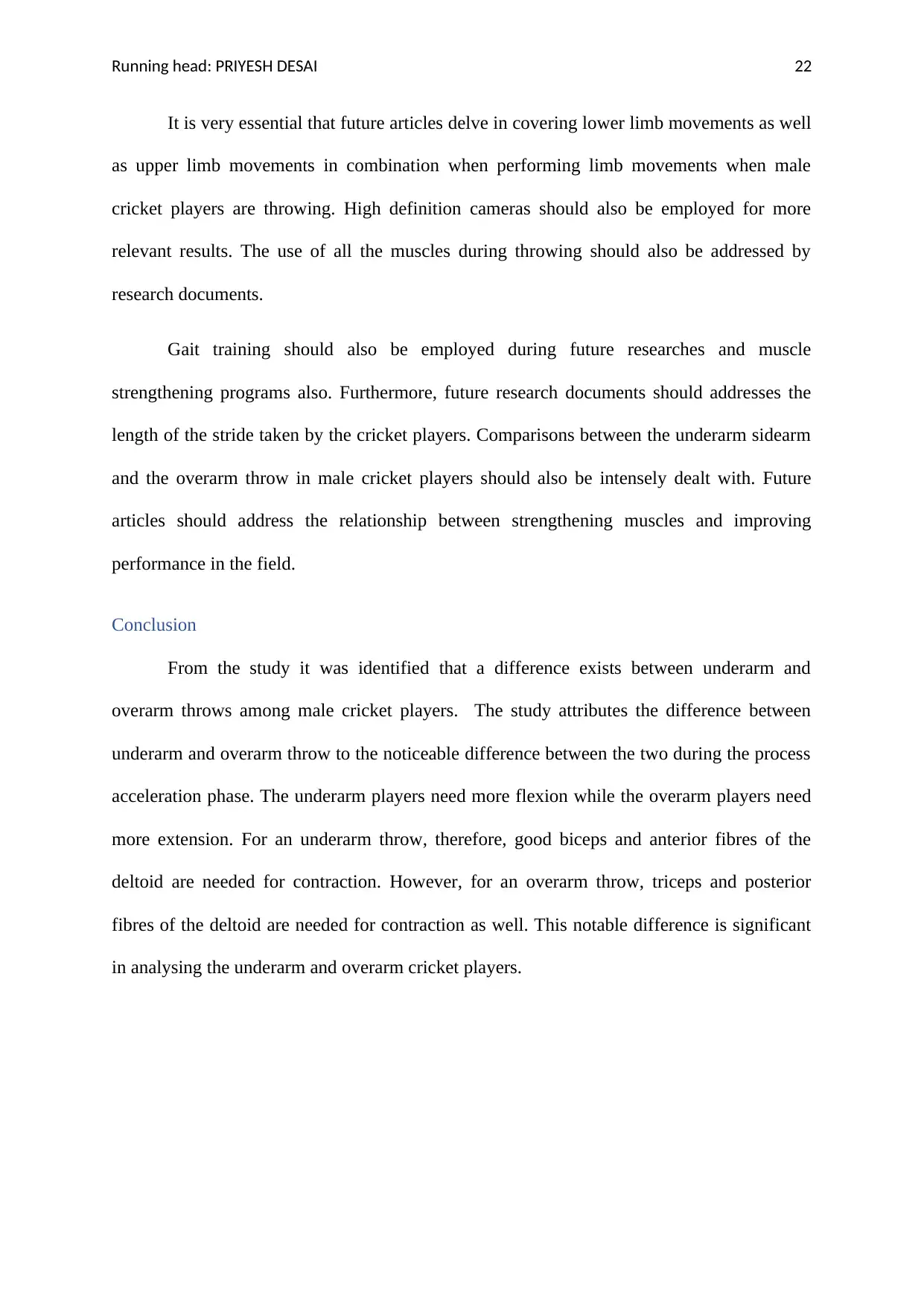
Running head: PRIYESH DESAI 22
It is very essential that future articles delve in covering lower limb movements as well
as upper limb movements in combination when performing limb movements when male
cricket players are throwing. High definition cameras should also be employed for more
relevant results. The use of all the muscles during throwing should also be addressed by
research documents.
Gait training should also be employed during future researches and muscle
strengthening programs also. Furthermore, future research documents should addresses the
length of the stride taken by the cricket players. Comparisons between the underarm sidearm
and the overarm throw in male cricket players should also be intensely dealt with. Future
articles should address the relationship between strengthening muscles and improving
performance in the field.
Conclusion
From the study it was identified that a difference exists between underarm and
overarm throws among male cricket players. The study attributes the difference between
underarm and overarm throw to the noticeable difference between the two during the process
acceleration phase. The underarm players need more flexion while the overarm players need
more extension. For an underarm throw, therefore, good biceps and anterior fibres of the
deltoid are needed for contraction. However, for an overarm throw, triceps and posterior
fibres of the deltoid are needed for contraction as well. This notable difference is significant
in analysing the underarm and overarm cricket players.
It is very essential that future articles delve in covering lower limb movements as well
as upper limb movements in combination when performing limb movements when male
cricket players are throwing. High definition cameras should also be employed for more
relevant results. The use of all the muscles during throwing should also be addressed by
research documents.
Gait training should also be employed during future researches and muscle
strengthening programs also. Furthermore, future research documents should addresses the
length of the stride taken by the cricket players. Comparisons between the underarm sidearm
and the overarm throw in male cricket players should also be intensely dealt with. Future
articles should address the relationship between strengthening muscles and improving
performance in the field.
Conclusion
From the study it was identified that a difference exists between underarm and
overarm throws among male cricket players. The study attributes the difference between
underarm and overarm throw to the noticeable difference between the two during the process
acceleration phase. The underarm players need more flexion while the overarm players need
more extension. For an underarm throw, therefore, good biceps and anterior fibres of the
deltoid are needed for contraction. However, for an overarm throw, triceps and posterior
fibres of the deltoid are needed for contraction as well. This notable difference is significant
in analysing the underarm and overarm cricket players.
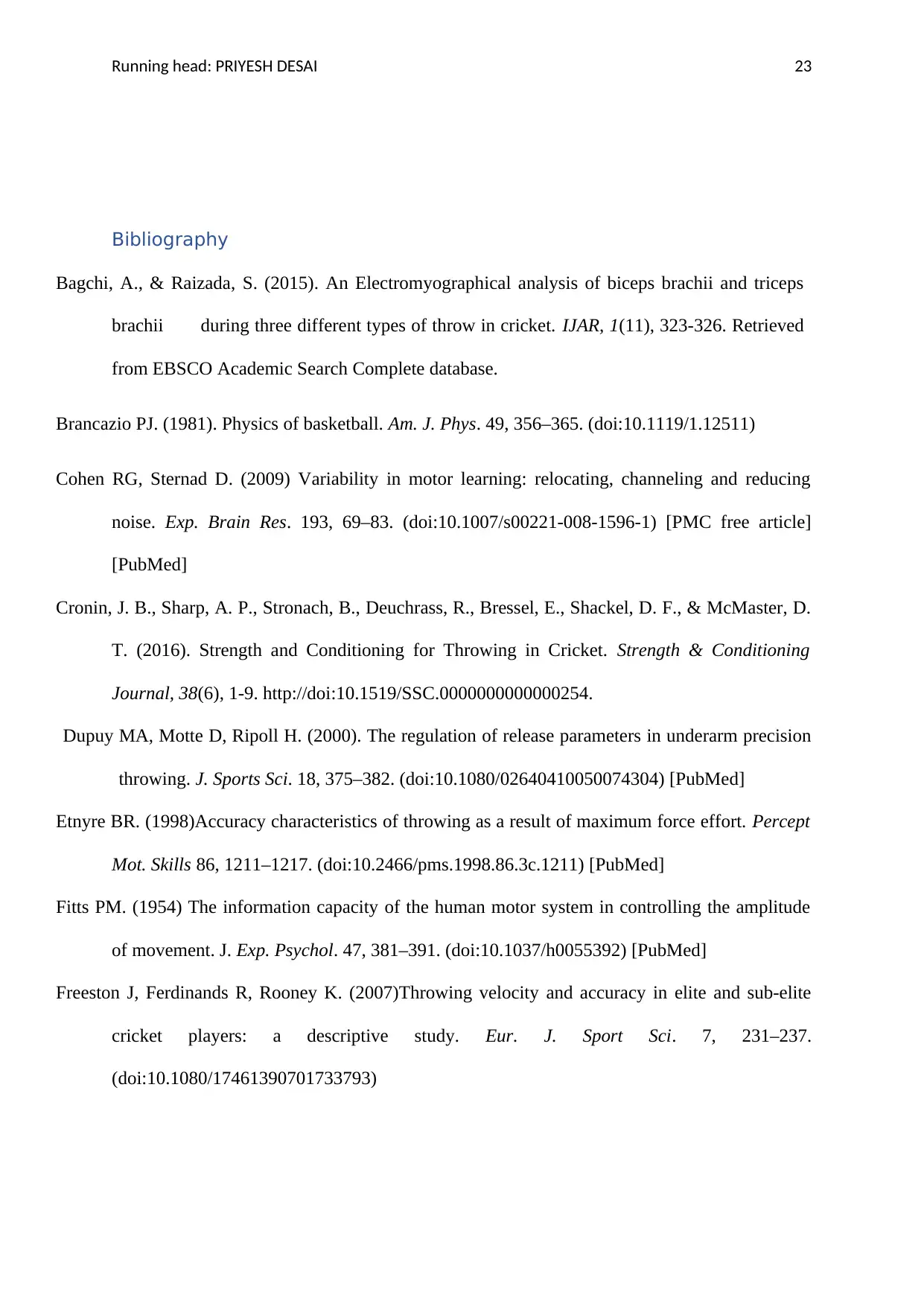
Running head: PRIYESH DESAI 23
Bibliography
Bagchi, A., & Raizada, S. (2015). An Electromyographical analysis of biceps brachii and triceps
brachii during three different types of throw in cricket. IJAR, 1(11), 323-326. Retrieved
from EBSCO Academic Search Complete database.
Brancazio PJ. (1981). Physics of basketball. Am. J. Phys. 49, 356–365. (doi:10.1119/1.12511)
Cohen RG, Sternad D. (2009) Variability in motor learning: relocating, channeling and reducing
noise. Exp. Brain Res. 193, 69–83. (doi:10.1007/s00221-008-1596-1) [PMC free article]
[PubMed]
Cronin, J. B., Sharp, A. P., Stronach, B., Deuchrass, R., Bressel, E., Shackel, D. F., & McMaster, D.
T. (2016). Strength and Conditioning for Throwing in Cricket. Strength & Conditioning
Journal, 38(6), 1-9. http://doi:10.1519/SSC.0000000000000254.
Dupuy MA, Motte D, Ripoll H. (2000). The regulation of release parameters in underarm precision
throwing. J. Sports Sci. 18, 375–382. (doi:10.1080/02640410050074304) [PubMed]
Etnyre BR. (1998)Accuracy characteristics of throwing as a result of maximum force effort. Percept
Mot. Skills 86, 1211–1217. (doi:10.2466/pms.1998.86.3c.1211) [PubMed]
Fitts PM. (1954) The information capacity of the human motor system in controlling the amplitude
of movement. J. Exp. Psychol. 47, 381–391. (doi:10.1037/h0055392) [PubMed]
Freeston J, Ferdinands R, Rooney K. (2007)Throwing velocity and accuracy in elite and sub-elite
cricket players: a descriptive study. Eur. J. Sport Sci. 7, 231–237.
(doi:10.1080/17461390701733793)
Bibliography
Bagchi, A., & Raizada, S. (2015). An Electromyographical analysis of biceps brachii and triceps
brachii during three different types of throw in cricket. IJAR, 1(11), 323-326. Retrieved
from EBSCO Academic Search Complete database.
Brancazio PJ. (1981). Physics of basketball. Am. J. Phys. 49, 356–365. (doi:10.1119/1.12511)
Cohen RG, Sternad D. (2009) Variability in motor learning: relocating, channeling and reducing
noise. Exp. Brain Res. 193, 69–83. (doi:10.1007/s00221-008-1596-1) [PMC free article]
[PubMed]
Cronin, J. B., Sharp, A. P., Stronach, B., Deuchrass, R., Bressel, E., Shackel, D. F., & McMaster, D.
T. (2016). Strength and Conditioning for Throwing in Cricket. Strength & Conditioning
Journal, 38(6), 1-9. http://doi:10.1519/SSC.0000000000000254.
Dupuy MA, Motte D, Ripoll H. (2000). The regulation of release parameters in underarm precision
throwing. J. Sports Sci. 18, 375–382. (doi:10.1080/02640410050074304) [PubMed]
Etnyre BR. (1998)Accuracy characteristics of throwing as a result of maximum force effort. Percept
Mot. Skills 86, 1211–1217. (doi:10.2466/pms.1998.86.3c.1211) [PubMed]
Fitts PM. (1954) The information capacity of the human motor system in controlling the amplitude
of movement. J. Exp. Psychol. 47, 381–391. (doi:10.1037/h0055392) [PubMed]
Freeston J, Ferdinands R, Rooney K. (2007)Throwing velocity and accuracy in elite and sub-elite
cricket players: a descriptive study. Eur. J. Sport Sci. 7, 231–237.
(doi:10.1080/17461390701733793)
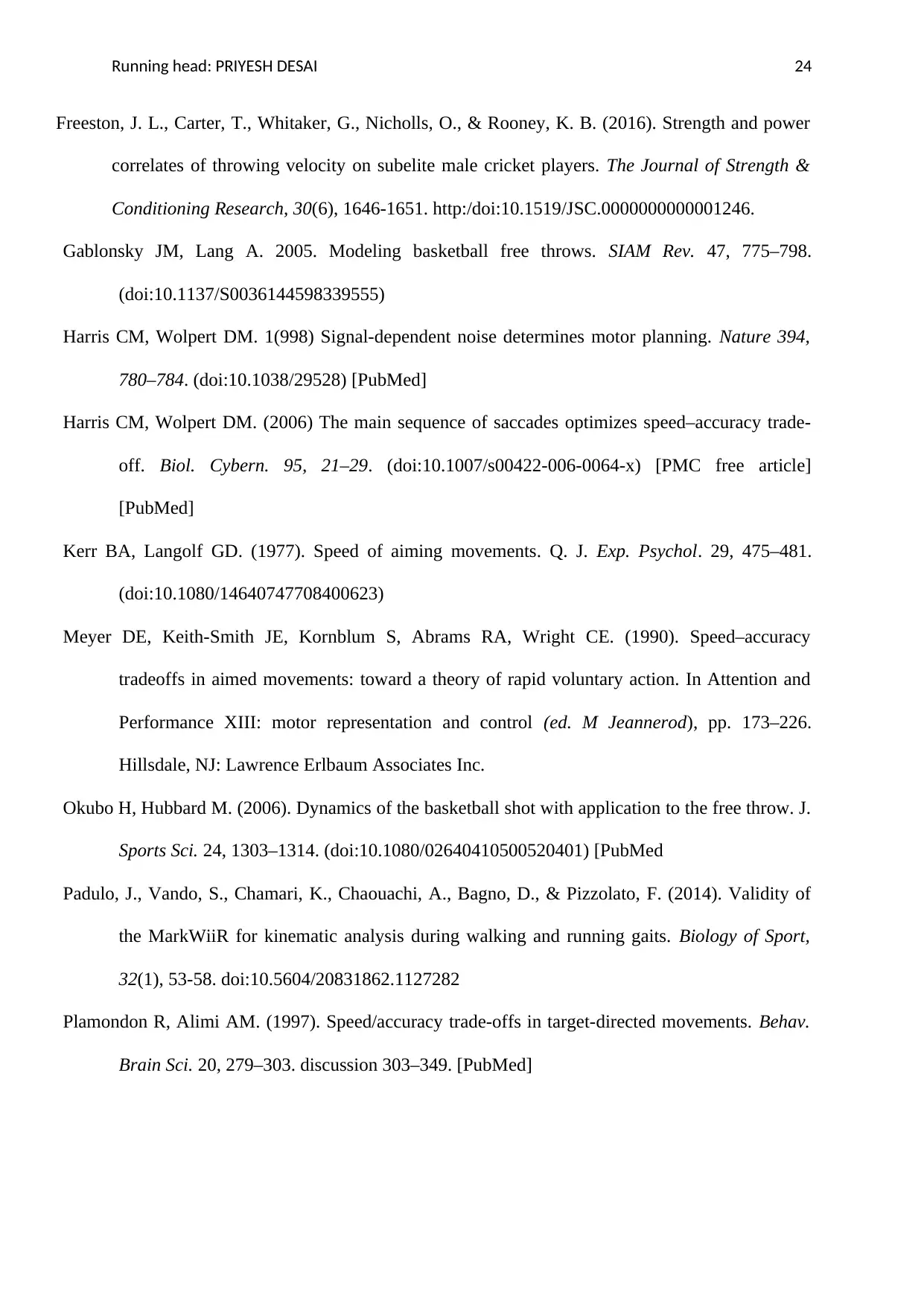
Running head: PRIYESH DESAI 24
Freeston, J. L., Carter, T., Whitaker, G., Nicholls, O., & Rooney, K. B. (2016). Strength and power
correlates of throwing velocity on subelite male cricket players. The Journal of Strength &
Conditioning Research, 30(6), 1646-1651. http:/doi:10.1519/JSC.0000000000001246.
Gablonsky JM, Lang A. 2005. Modeling basketball free throws. SIAM Rev. 47, 775–798.
(doi:10.1137/S0036144598339555)
Harris CM, Wolpert DM. 1(998) Signal-dependent noise determines motor planning. Nature 394,
780–784. (doi:10.1038/29528) [PubMed]
Harris CM, Wolpert DM. (2006) The main sequence of saccades optimizes speed–accuracy trade-
off. Biol. Cybern. 95, 21–29. (doi:10.1007/s00422-006-0064-x) [PMC free article]
[PubMed]
Kerr BA, Langolf GD. (1977). Speed of aiming movements. Q. J. Exp. Psychol. 29, 475–481.
(doi:10.1080/14640747708400623)
Meyer DE, Keith-Smith JE, Kornblum S, Abrams RA, Wright CE. (1990). Speed–accuracy
tradeoffs in aimed movements: toward a theory of rapid voluntary action. In Attention and
Performance XIII: motor representation and control (ed. M Jeannerod), pp. 173–226.
Hillsdale, NJ: Lawrence Erlbaum Associates Inc.
Okubo H, Hubbard M. (2006). Dynamics of the basketball shot with application to the free throw. J.
Sports Sci. 24, 1303–1314. (doi:10.1080/02640410500520401) [PubMed
Padulo, J., Vando, S., Chamari, K., Chaouachi, A., Bagno, D., & Pizzolato, F. (2014). Validity of
the MarkWiiR for kinematic analysis during walking and running gaits. Biology of Sport,
32(1), 53-58. doi:10.5604/20831862.1127282
Plamondon R, Alimi AM. (1997). Speed/accuracy trade-offs in target-directed movements. Behav.
Brain Sci. 20, 279–303. discussion 303–349. [PubMed]
Freeston, J. L., Carter, T., Whitaker, G., Nicholls, O., & Rooney, K. B. (2016). Strength and power
correlates of throwing velocity on subelite male cricket players. The Journal of Strength &
Conditioning Research, 30(6), 1646-1651. http:/doi:10.1519/JSC.0000000000001246.
Gablonsky JM, Lang A. 2005. Modeling basketball free throws. SIAM Rev. 47, 775–798.
(doi:10.1137/S0036144598339555)
Harris CM, Wolpert DM. 1(998) Signal-dependent noise determines motor planning. Nature 394,
780–784. (doi:10.1038/29528) [PubMed]
Harris CM, Wolpert DM. (2006) The main sequence of saccades optimizes speed–accuracy trade-
off. Biol. Cybern. 95, 21–29. (doi:10.1007/s00422-006-0064-x) [PMC free article]
[PubMed]
Kerr BA, Langolf GD. (1977). Speed of aiming movements. Q. J. Exp. Psychol. 29, 475–481.
(doi:10.1080/14640747708400623)
Meyer DE, Keith-Smith JE, Kornblum S, Abrams RA, Wright CE. (1990). Speed–accuracy
tradeoffs in aimed movements: toward a theory of rapid voluntary action. In Attention and
Performance XIII: motor representation and control (ed. M Jeannerod), pp. 173–226.
Hillsdale, NJ: Lawrence Erlbaum Associates Inc.
Okubo H, Hubbard M. (2006). Dynamics of the basketball shot with application to the free throw. J.
Sports Sci. 24, 1303–1314. (doi:10.1080/02640410500520401) [PubMed
Padulo, J., Vando, S., Chamari, K., Chaouachi, A., Bagno, D., & Pizzolato, F. (2014). Validity of
the MarkWiiR for kinematic analysis during walking and running gaits. Biology of Sport,
32(1), 53-58. doi:10.5604/20831862.1127282
Plamondon R, Alimi AM. (1997). Speed/accuracy trade-offs in target-directed movements. Behav.
Brain Sci. 20, 279–303. discussion 303–349. [PubMed]
Paraphrase This Document
Need a fresh take? Get an instant paraphrase of this document with our AI Paraphraser
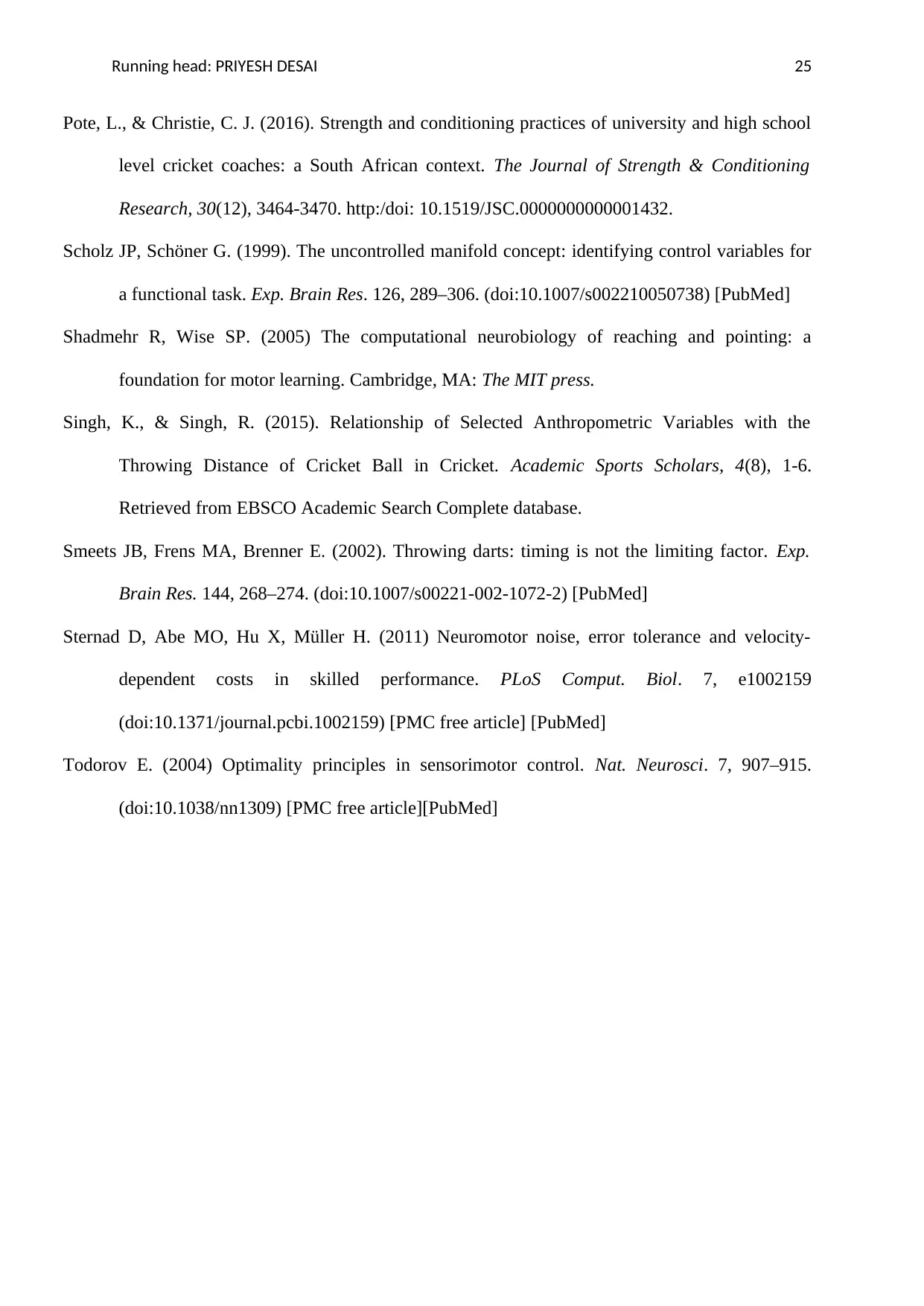
Running head: PRIYESH DESAI 25
Pote, L., & Christie, C. J. (2016). Strength and conditioning practices of university and high school
level cricket coaches: a South African context. The Journal of Strength & Conditioning
Research, 30(12), 3464-3470. http:/doi: 10.1519/JSC.0000000000001432.
Scholz JP, Schöner G. (1999). The uncontrolled manifold concept: identifying control variables for
a functional task. Exp. Brain Res. 126, 289–306. (doi:10.1007/s002210050738) [PubMed]
Shadmehr R, Wise SP. (2005) The computational neurobiology of reaching and pointing: a
foundation for motor learning. Cambridge, MA: The MIT press.
Singh, K., & Singh, R. (2015). Relationship of Selected Anthropometric Variables with the
Throwing Distance of Cricket Ball in Cricket. Academic Sports Scholars, 4(8), 1-6.
Retrieved from EBSCO Academic Search Complete database.
Smeets JB, Frens MA, Brenner E. (2002). Throwing darts: timing is not the limiting factor. Exp.
Brain Res. 144, 268–274. (doi:10.1007/s00221-002-1072-2) [PubMed]
Sternad D, Abe MO, Hu X, Müller H. (2011) Neuromotor noise, error tolerance and velocity-
dependent costs in skilled performance. PLoS Comput. Biol. 7, e1002159
(doi:10.1371/journal.pcbi.1002159) [PMC free article] [PubMed]
Todorov E. (2004) Optimality principles in sensorimotor control. Nat. Neurosci. 7, 907–915.
(doi:10.1038/nn1309) [PMC free article][PubMed]
Pote, L., & Christie, C. J. (2016). Strength and conditioning practices of university and high school
level cricket coaches: a South African context. The Journal of Strength & Conditioning
Research, 30(12), 3464-3470. http:/doi: 10.1519/JSC.0000000000001432.
Scholz JP, Schöner G. (1999). The uncontrolled manifold concept: identifying control variables for
a functional task. Exp. Brain Res. 126, 289–306. (doi:10.1007/s002210050738) [PubMed]
Shadmehr R, Wise SP. (2005) The computational neurobiology of reaching and pointing: a
foundation for motor learning. Cambridge, MA: The MIT press.
Singh, K., & Singh, R. (2015). Relationship of Selected Anthropometric Variables with the
Throwing Distance of Cricket Ball in Cricket. Academic Sports Scholars, 4(8), 1-6.
Retrieved from EBSCO Academic Search Complete database.
Smeets JB, Frens MA, Brenner E. (2002). Throwing darts: timing is not the limiting factor. Exp.
Brain Res. 144, 268–274. (doi:10.1007/s00221-002-1072-2) [PubMed]
Sternad D, Abe MO, Hu X, Müller H. (2011) Neuromotor noise, error tolerance and velocity-
dependent costs in skilled performance. PLoS Comput. Biol. 7, e1002159
(doi:10.1371/journal.pcbi.1002159) [PMC free article] [PubMed]
Todorov E. (2004) Optimality principles in sensorimotor control. Nat. Neurosci. 7, 907–915.
(doi:10.1038/nn1309) [PMC free article][PubMed]
1 out of 26
Your All-in-One AI-Powered Toolkit for Academic Success.
+13062052269
info@desklib.com
Available 24*7 on WhatsApp / Email
![[object Object]](/_next/static/media/star-bottom.7253800d.svg)
Unlock your academic potential
© 2024 | Zucol Services PVT LTD | All rights reserved.